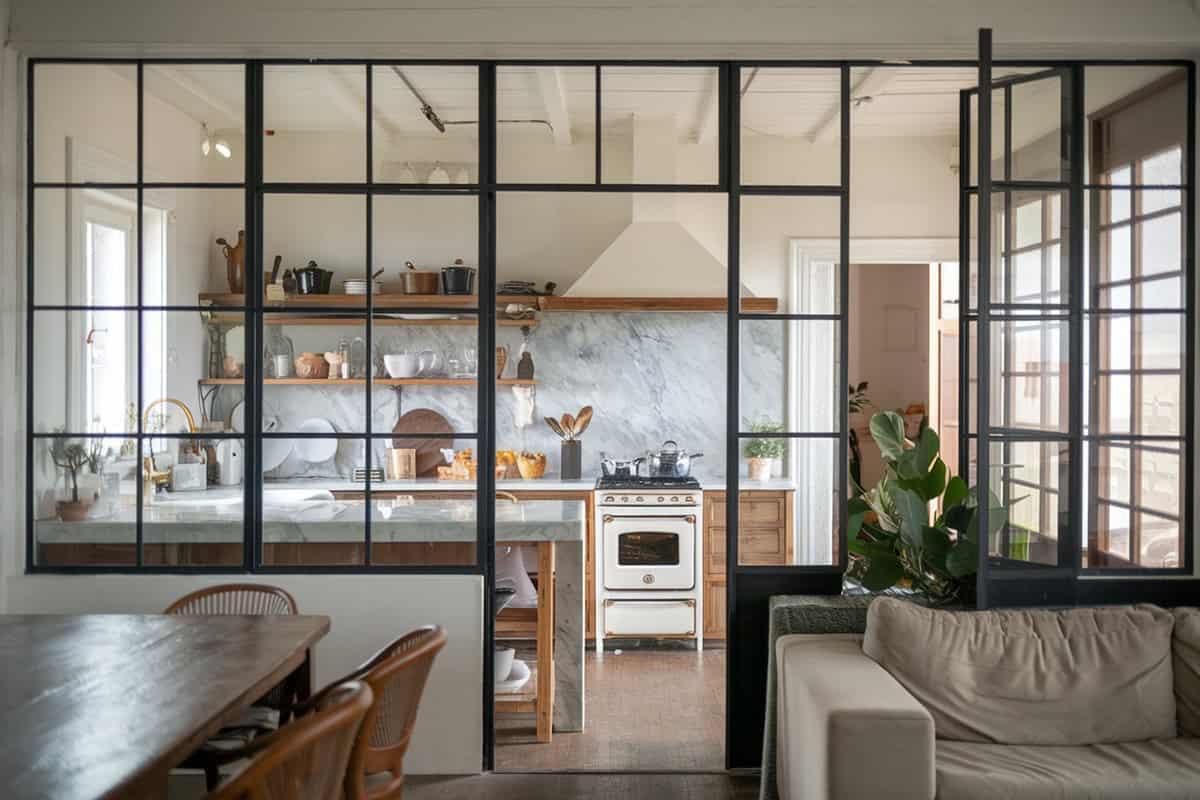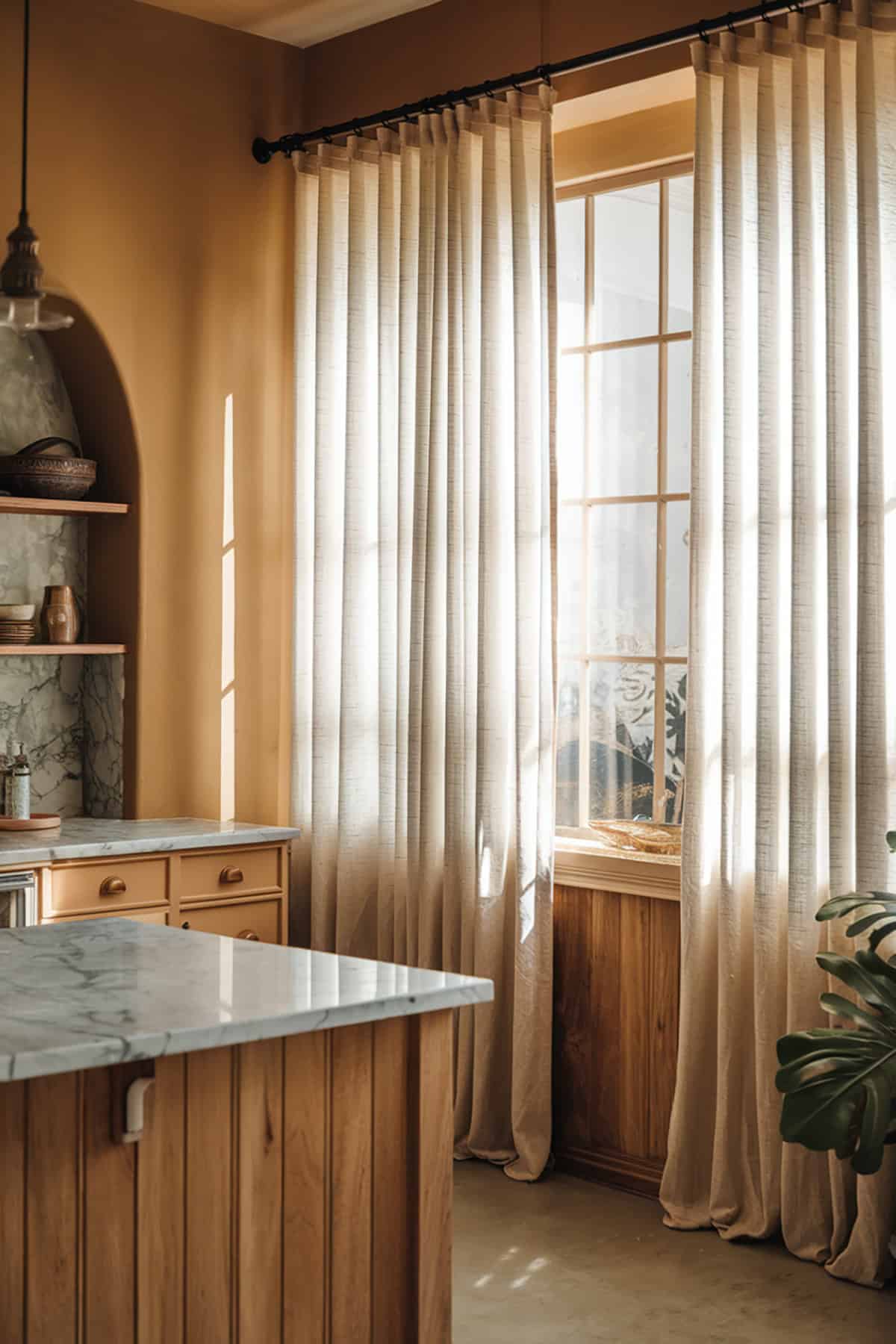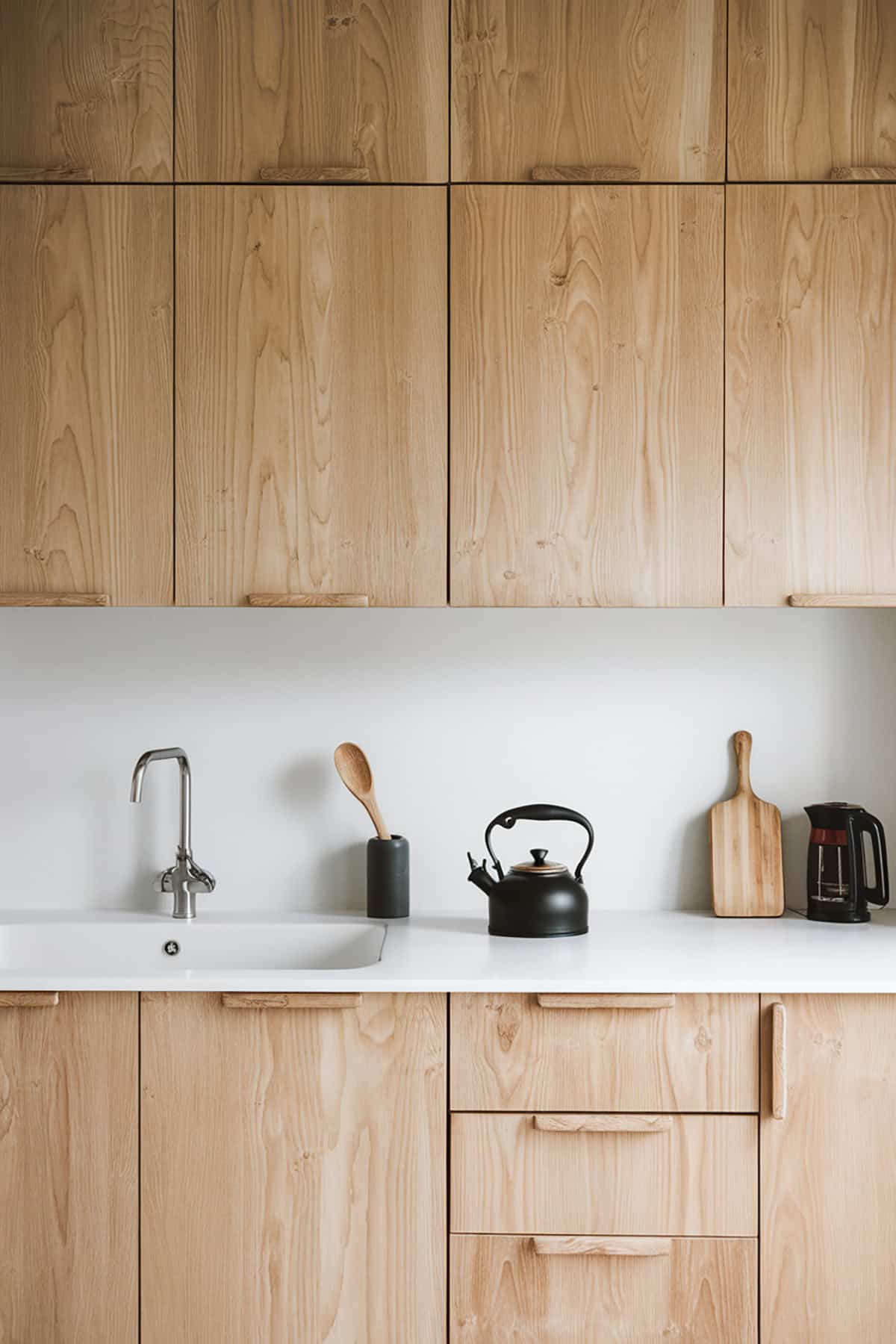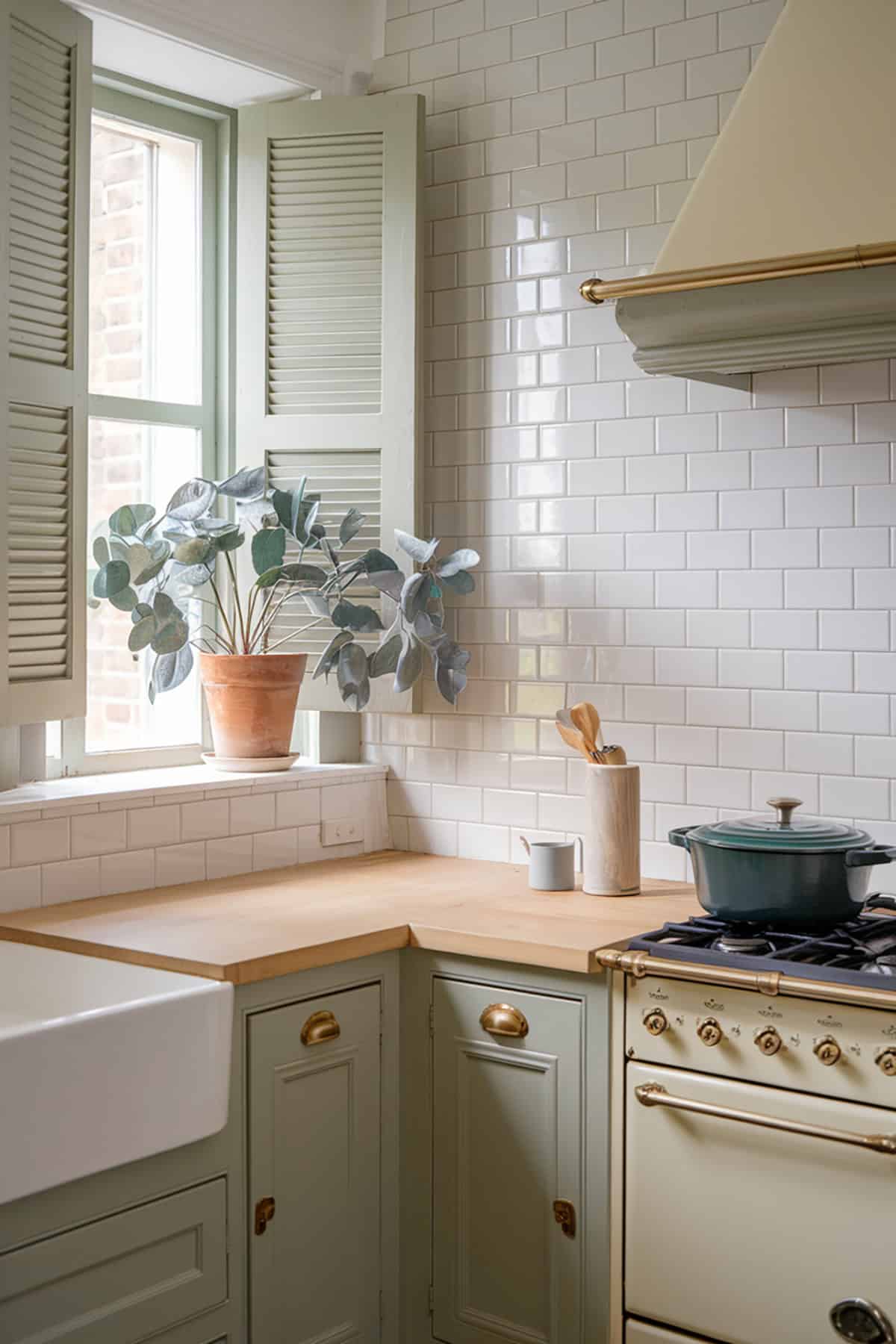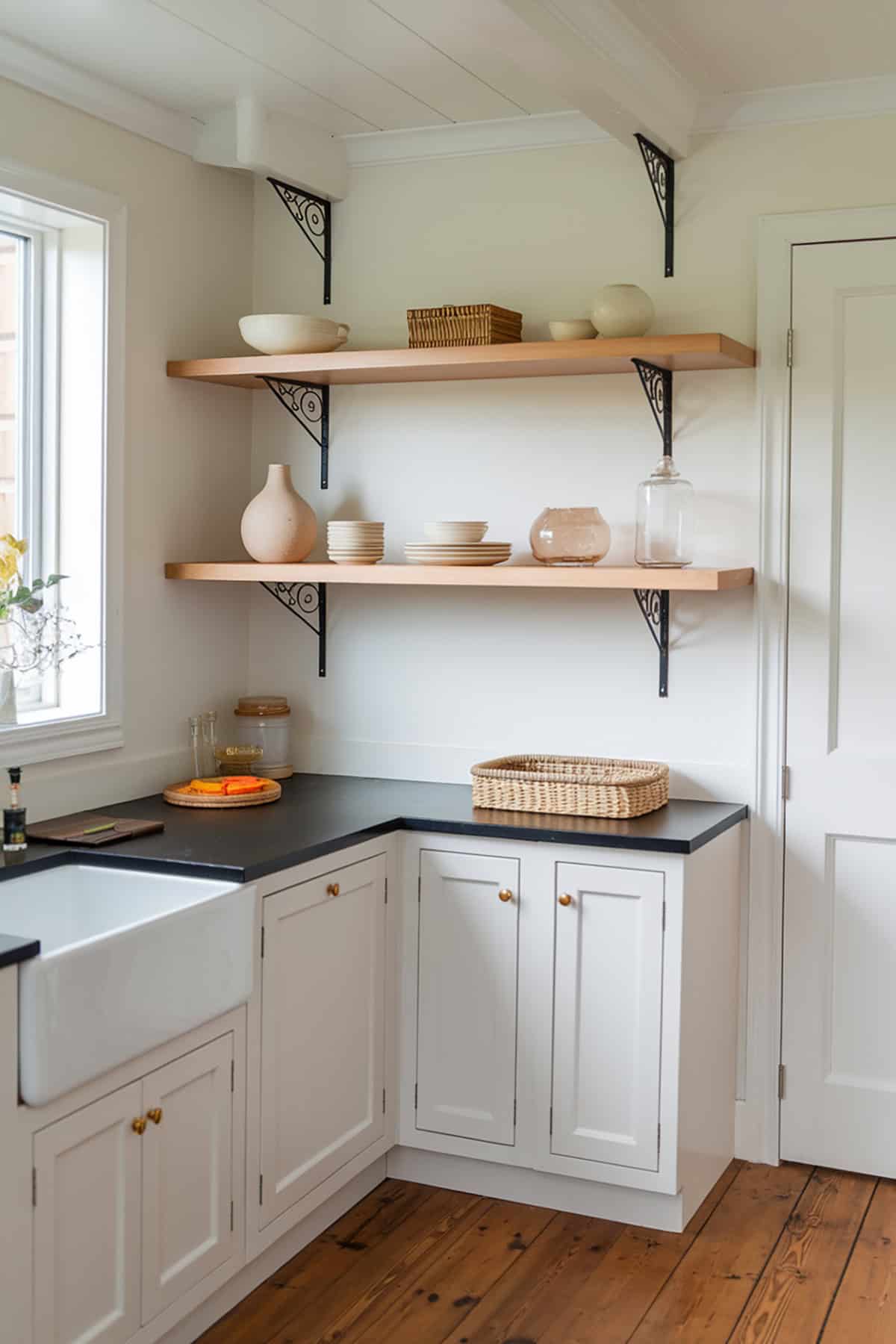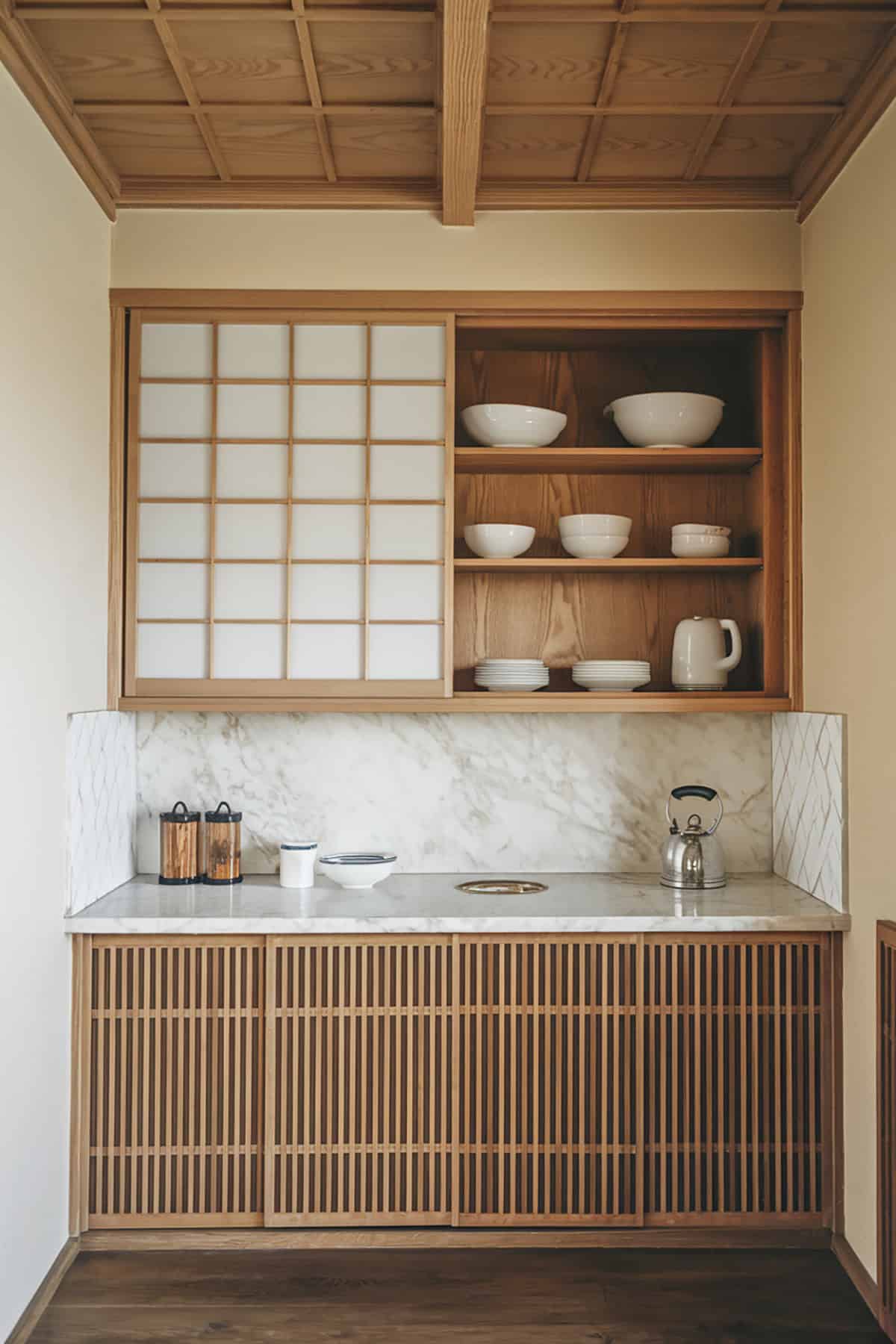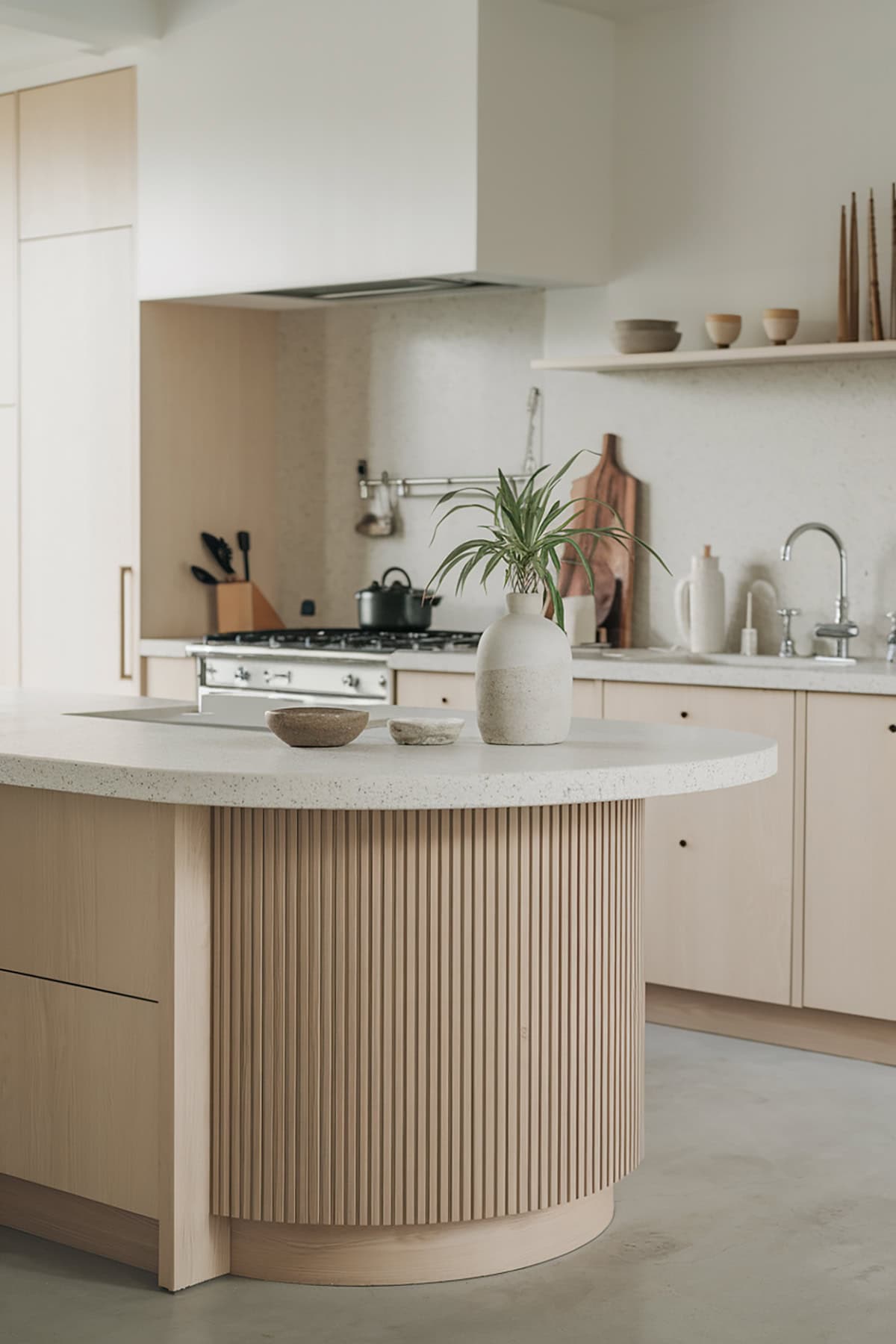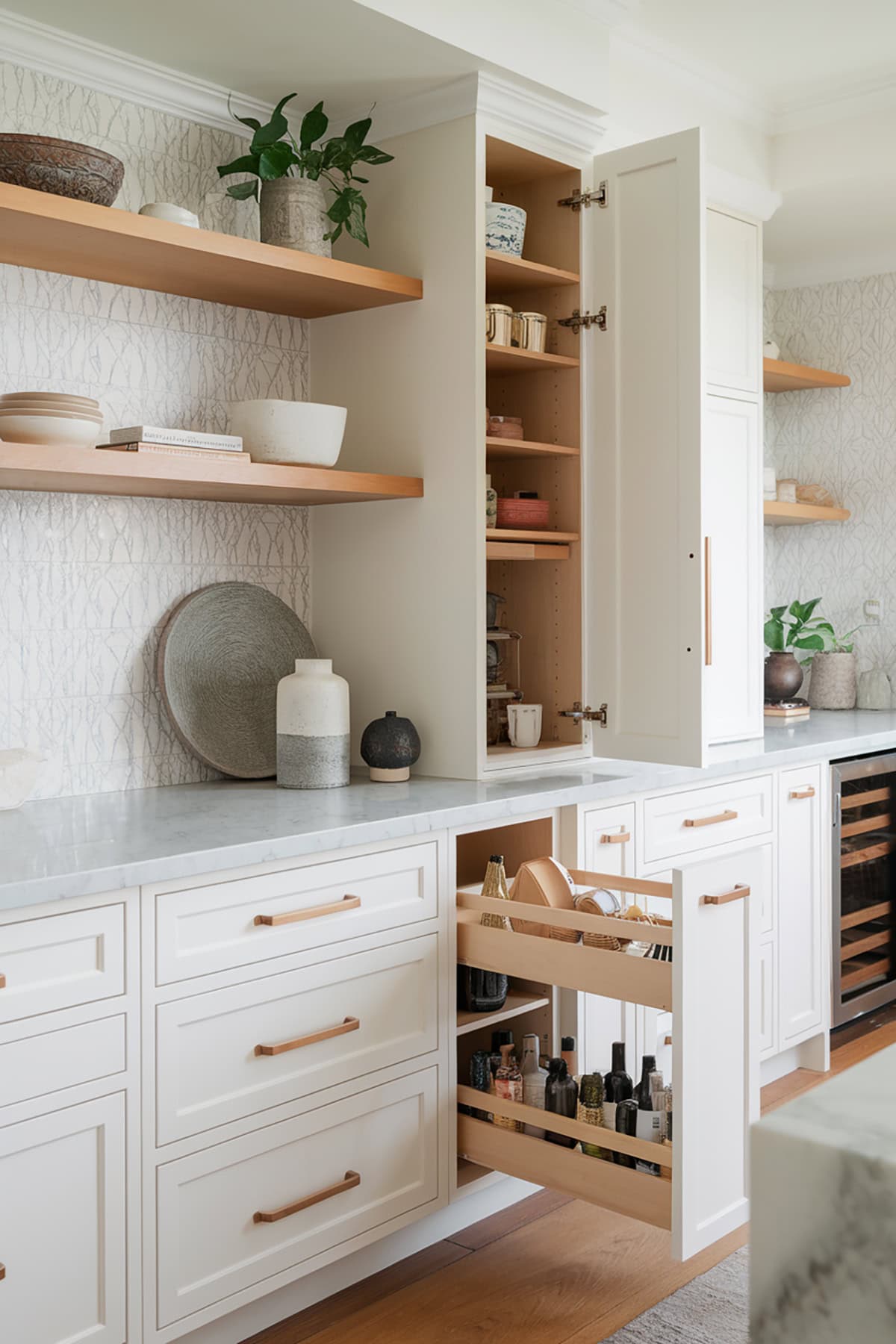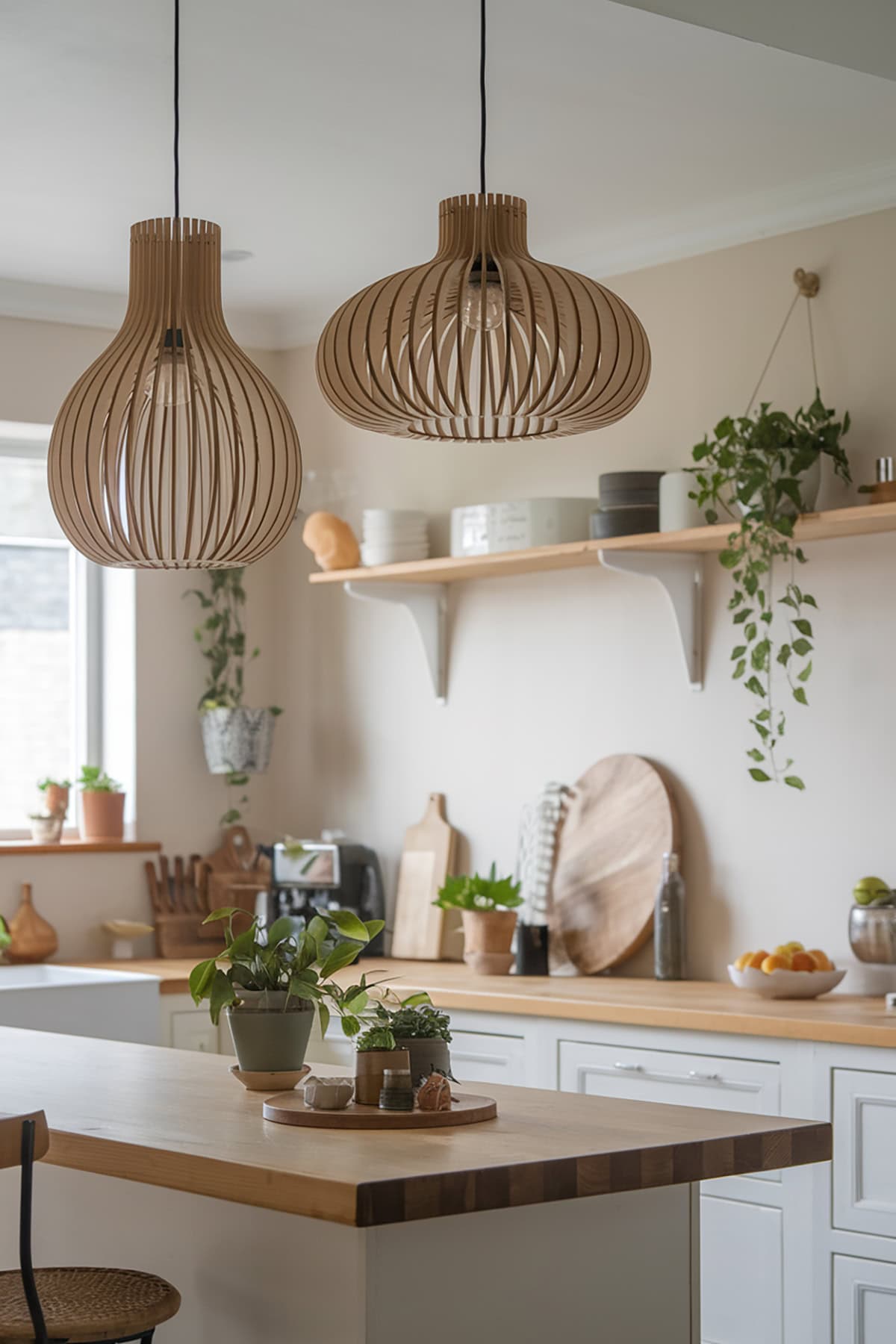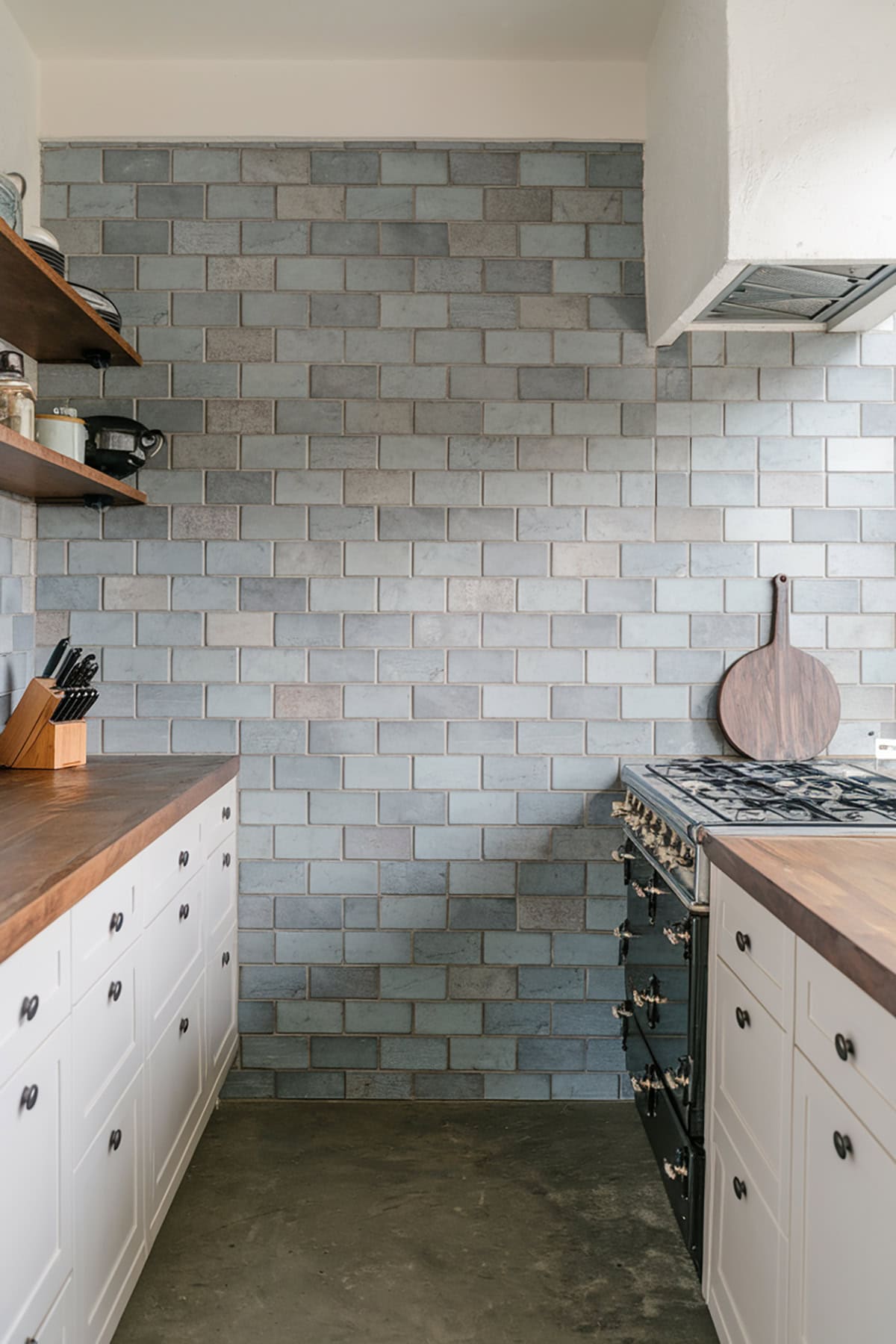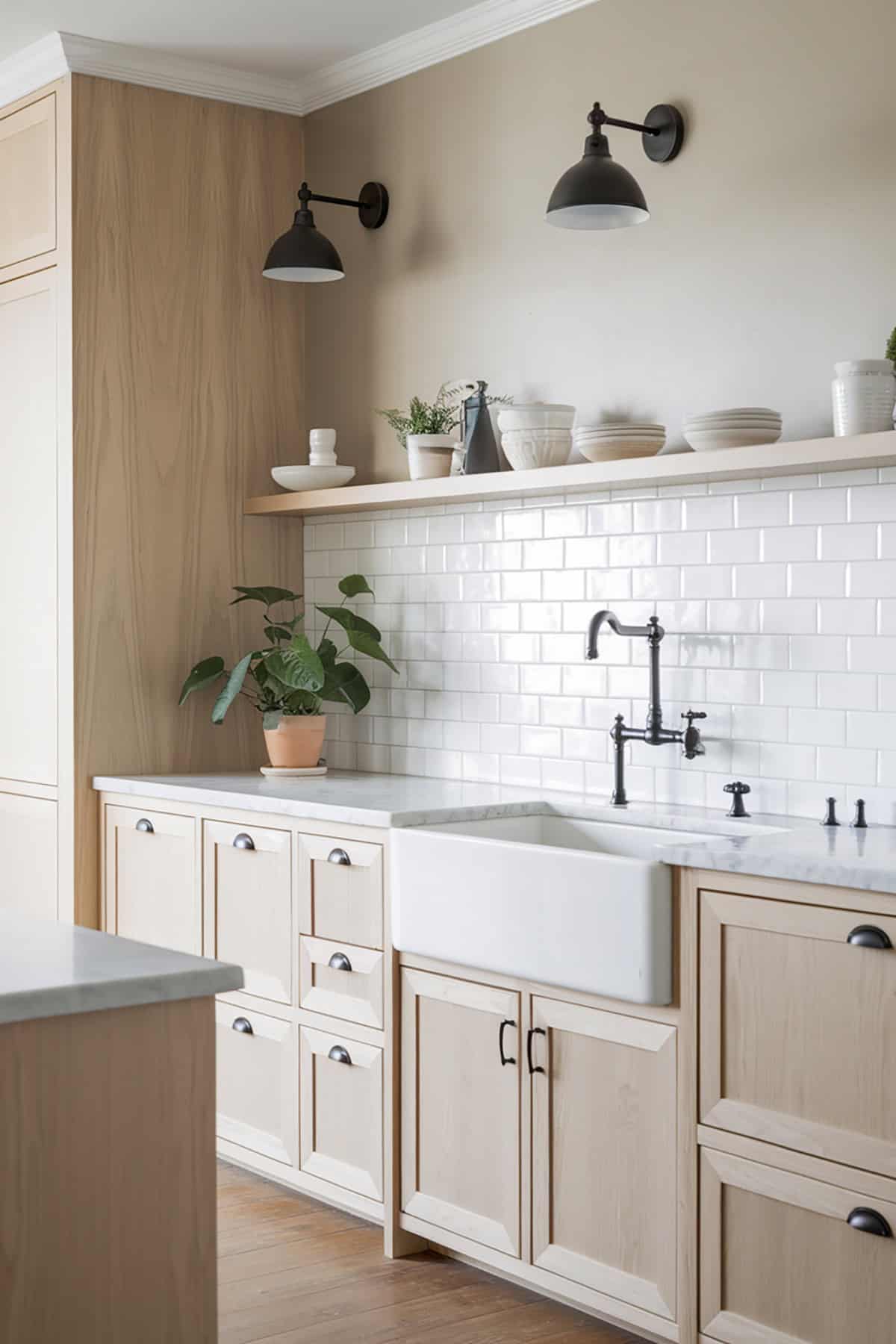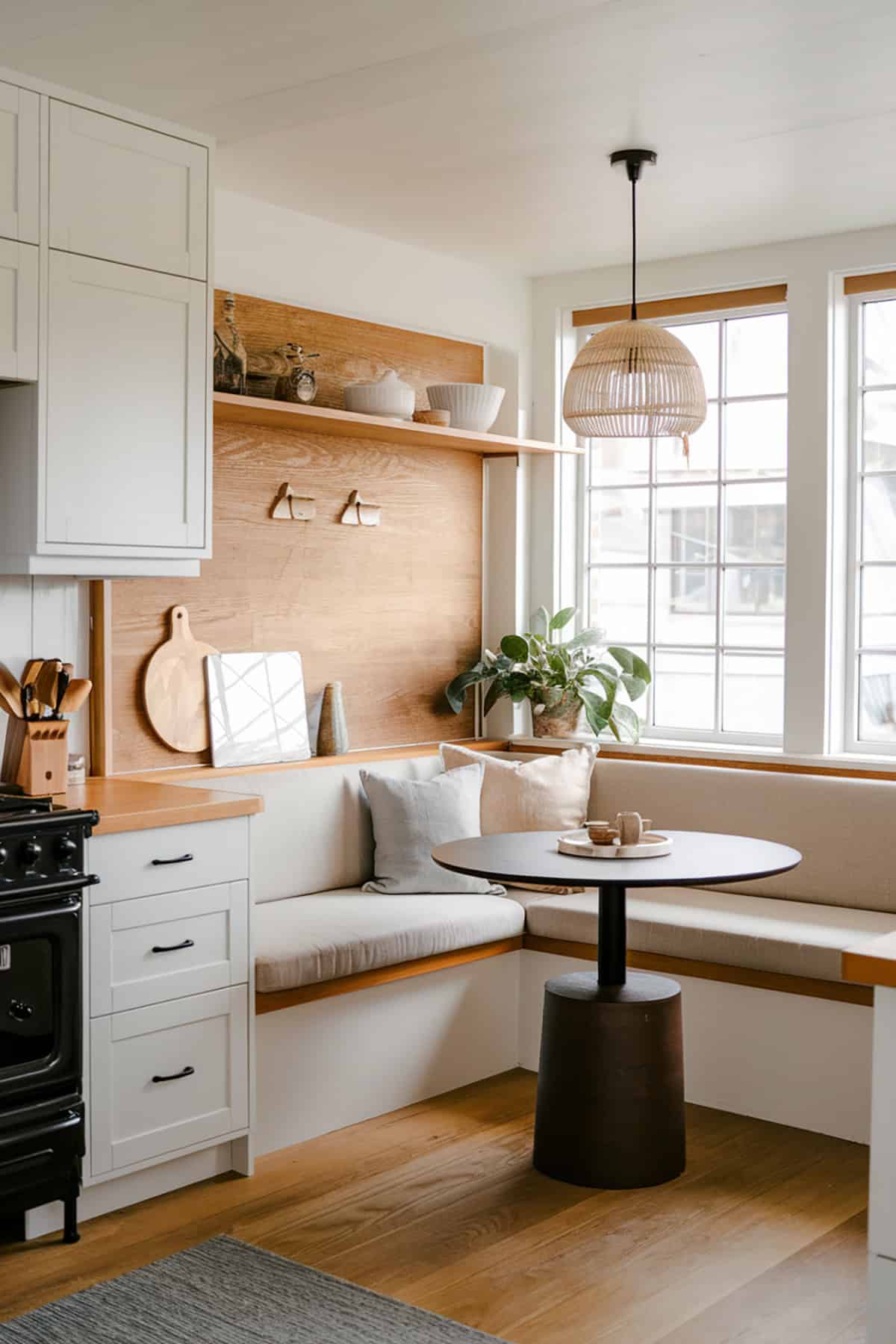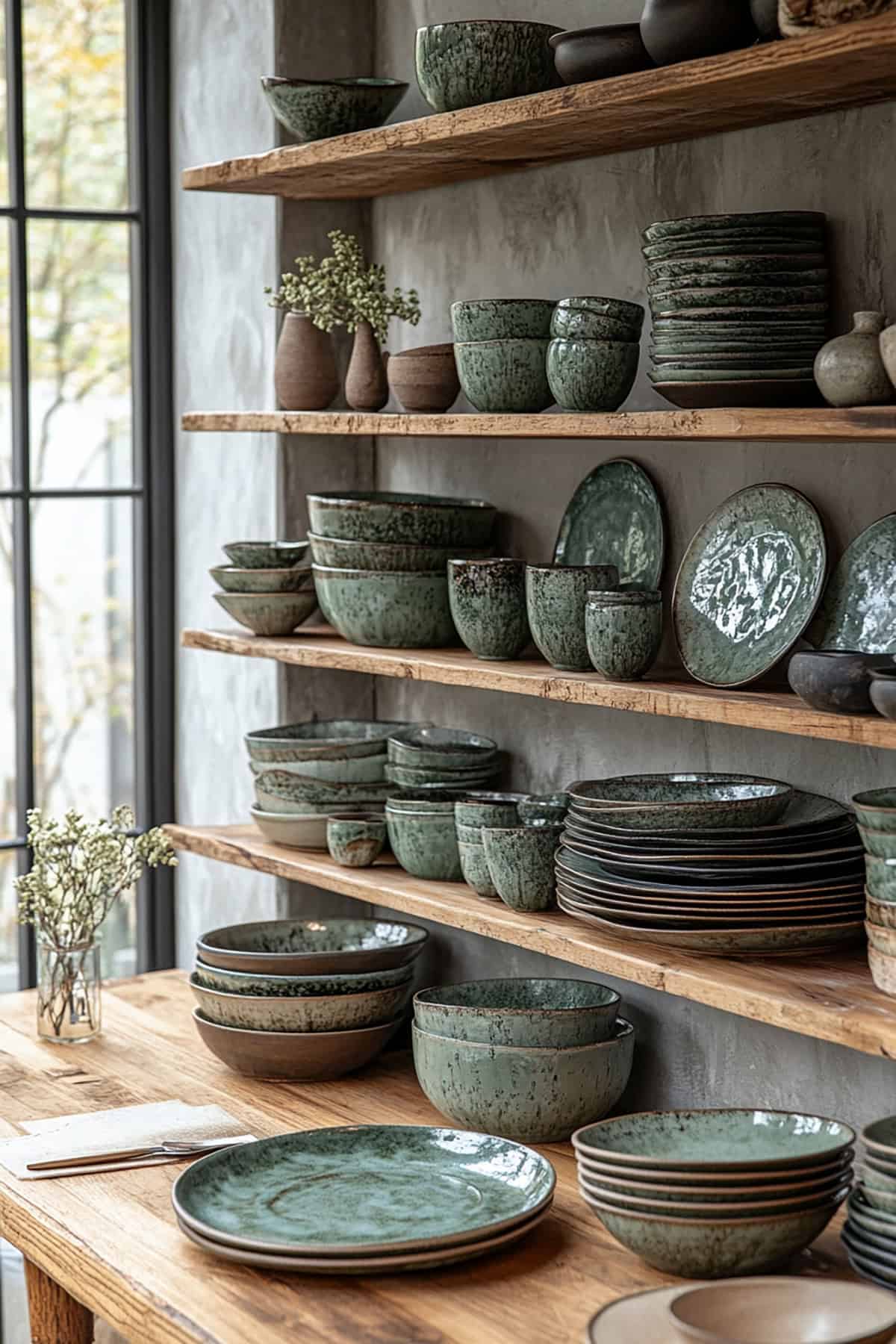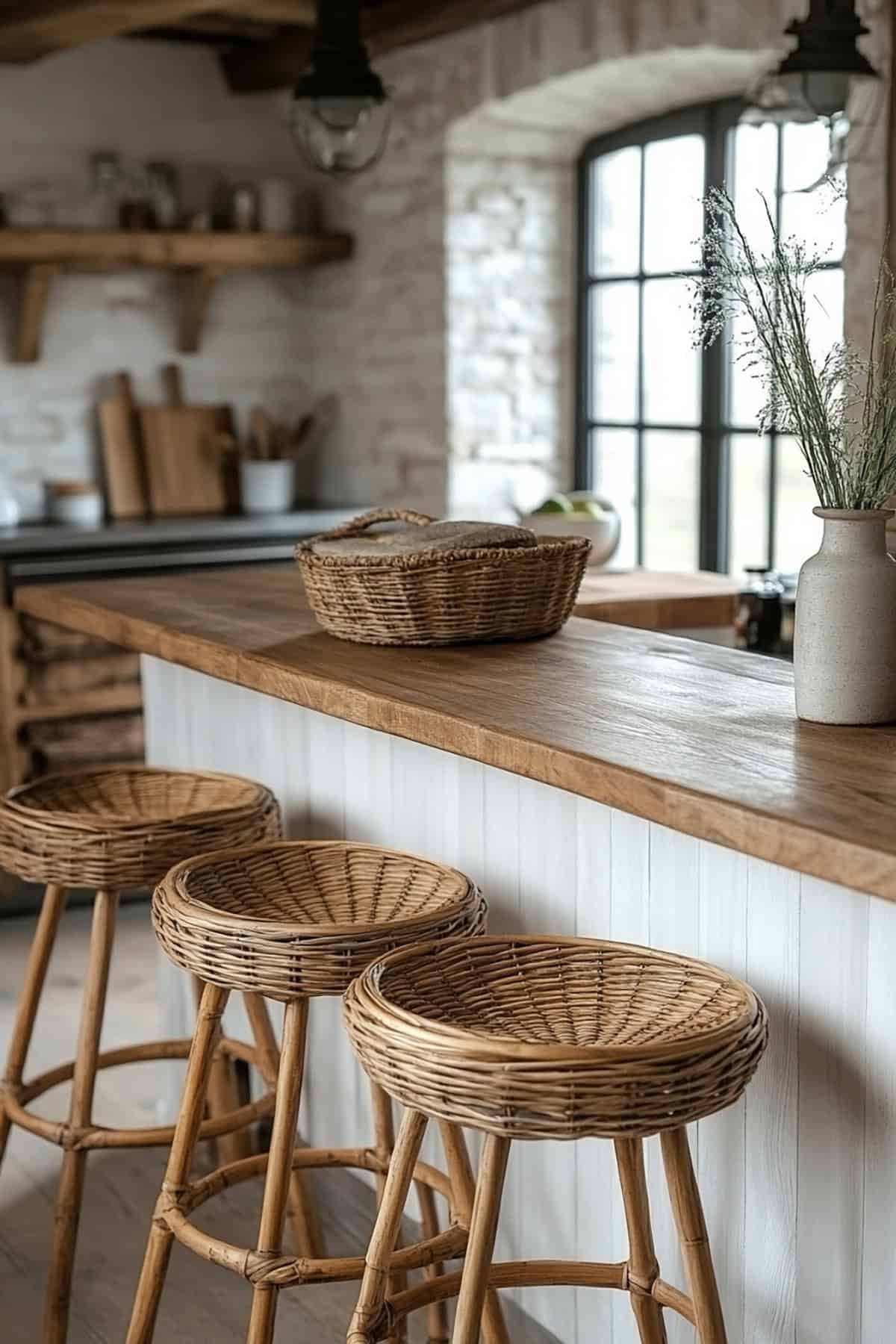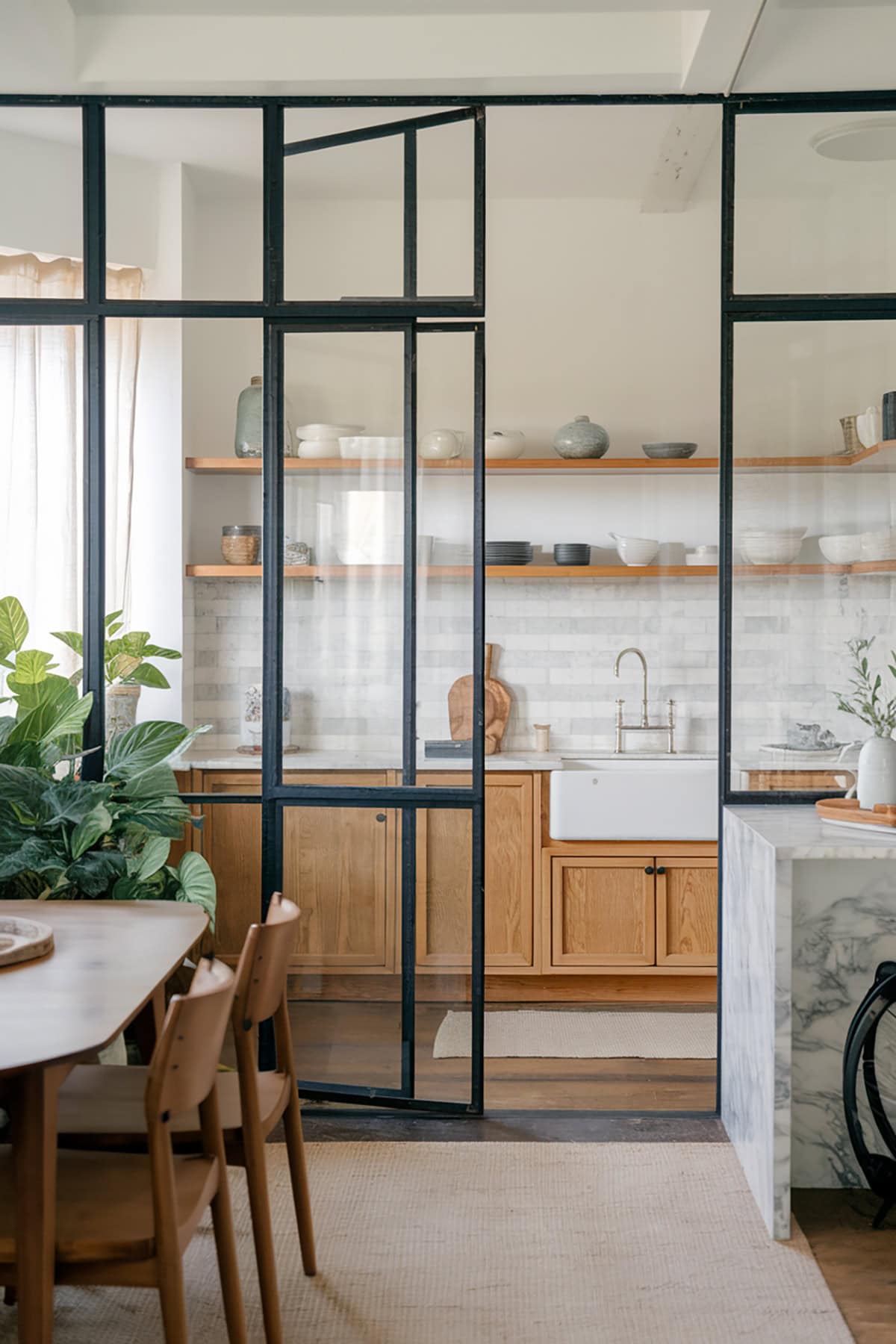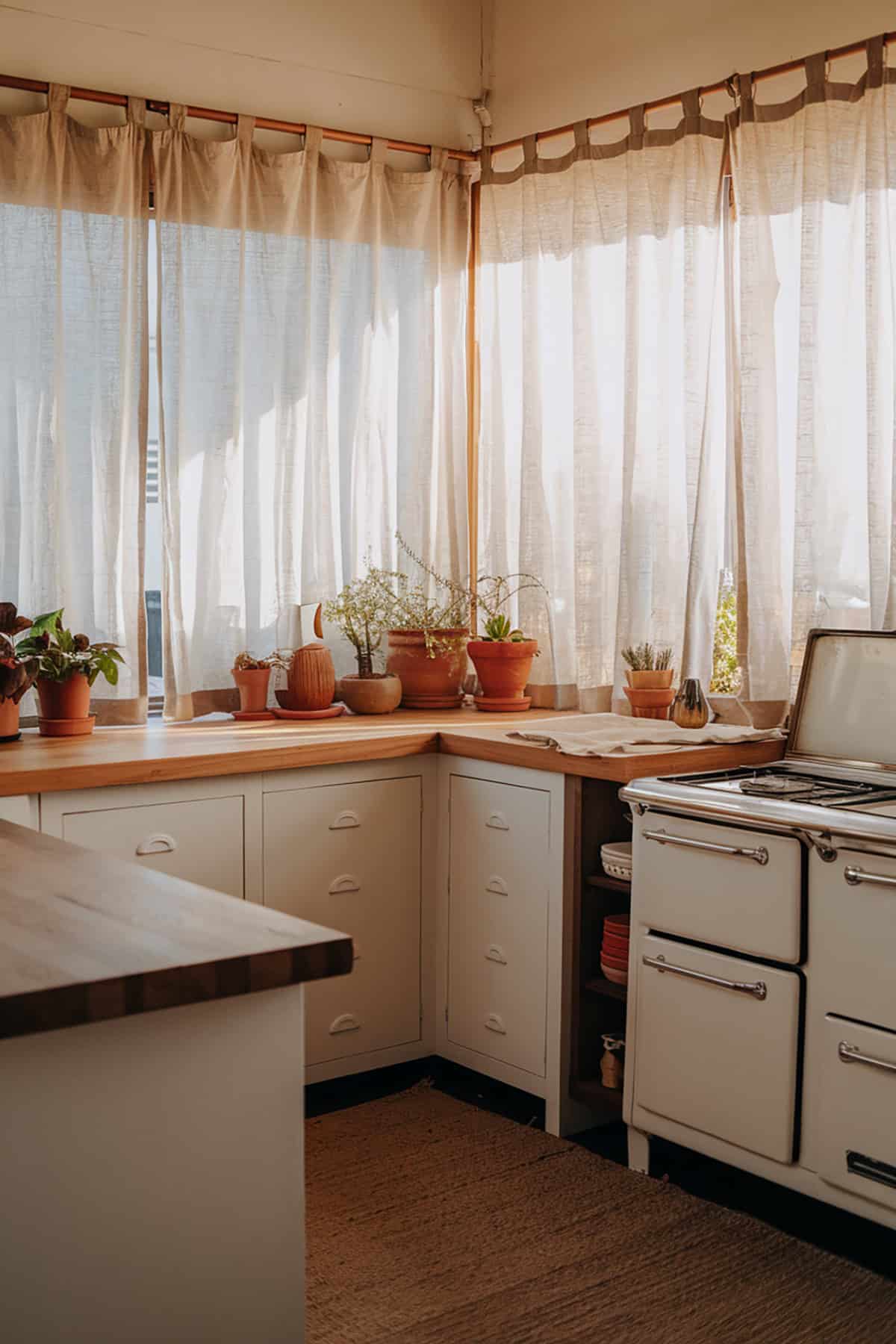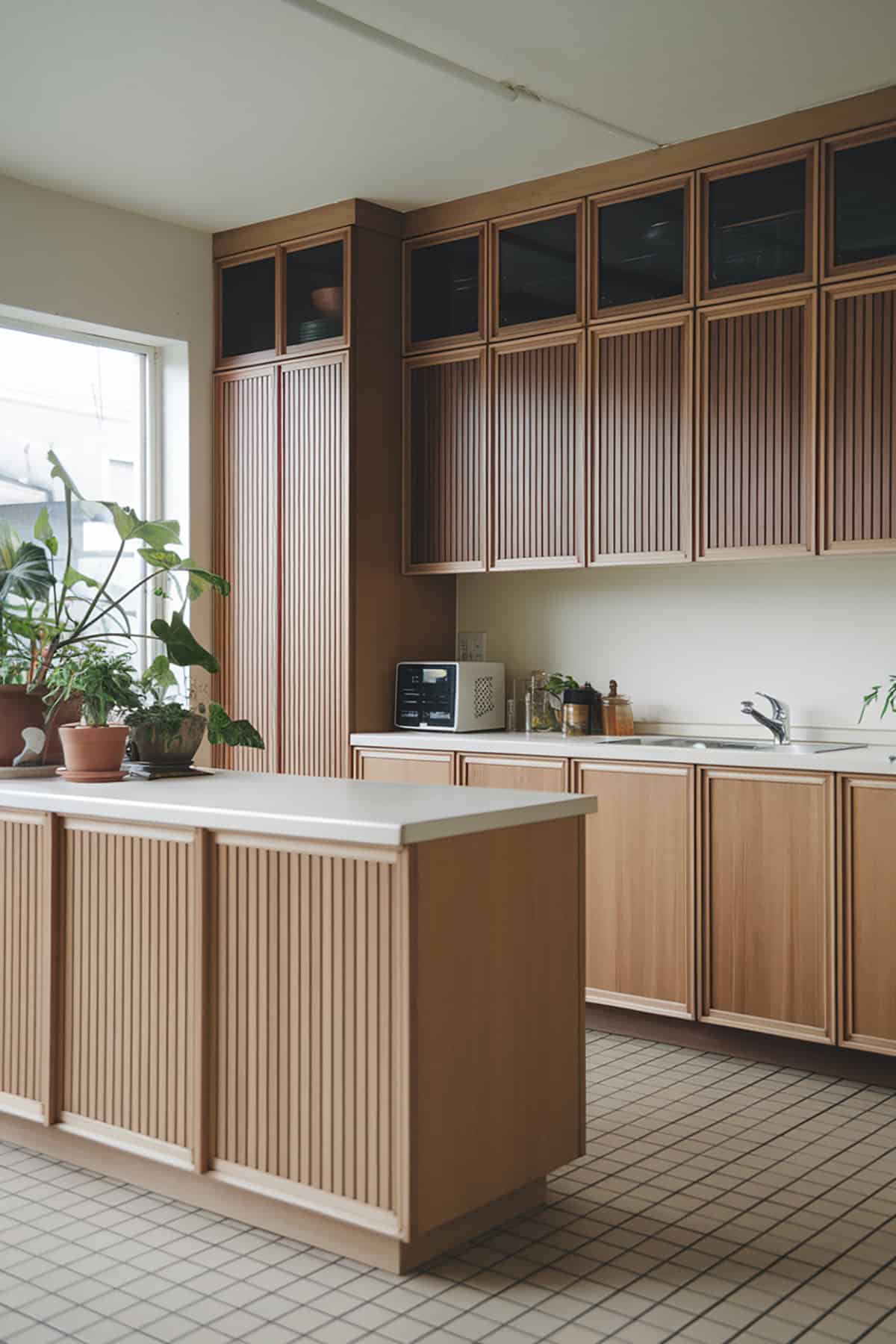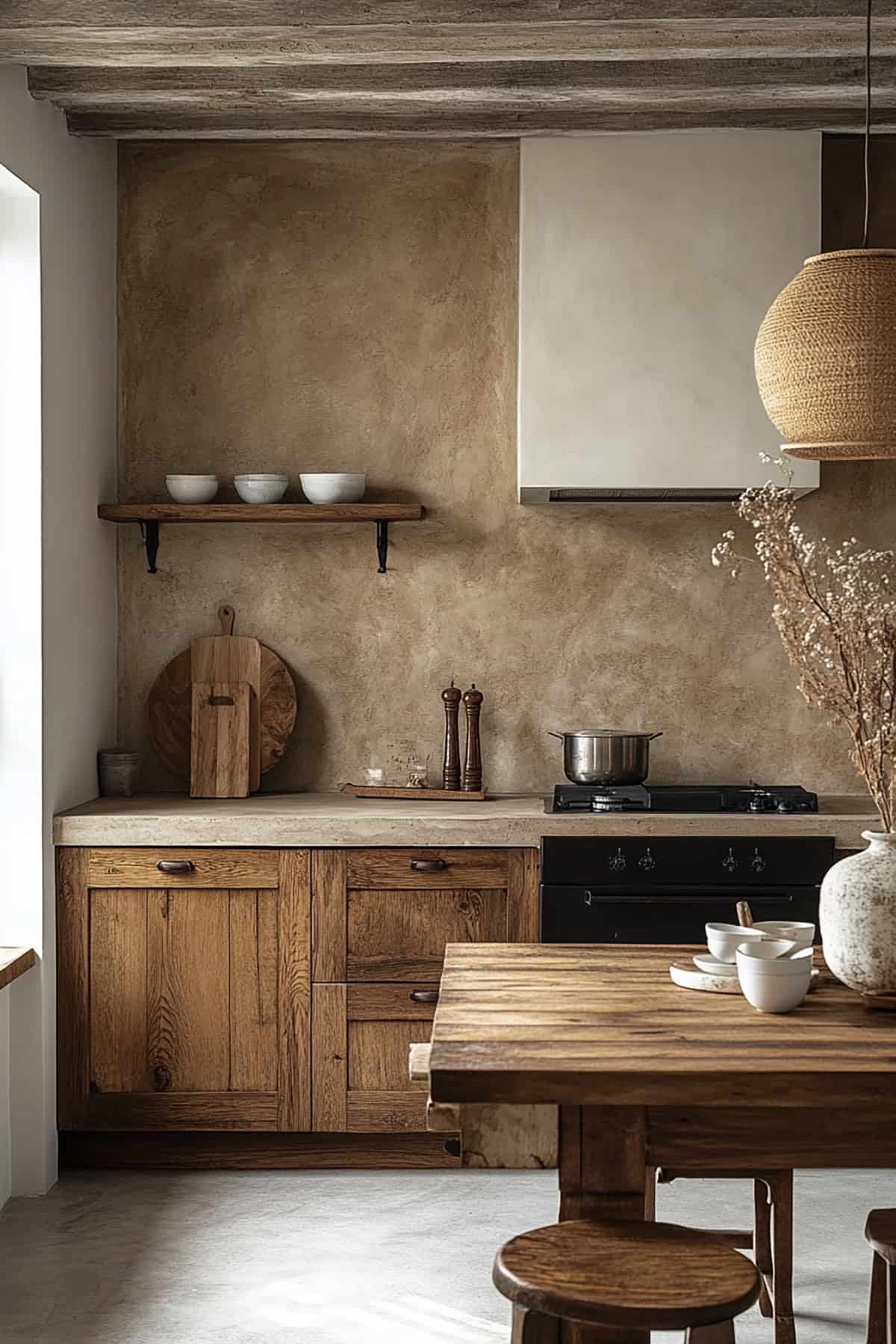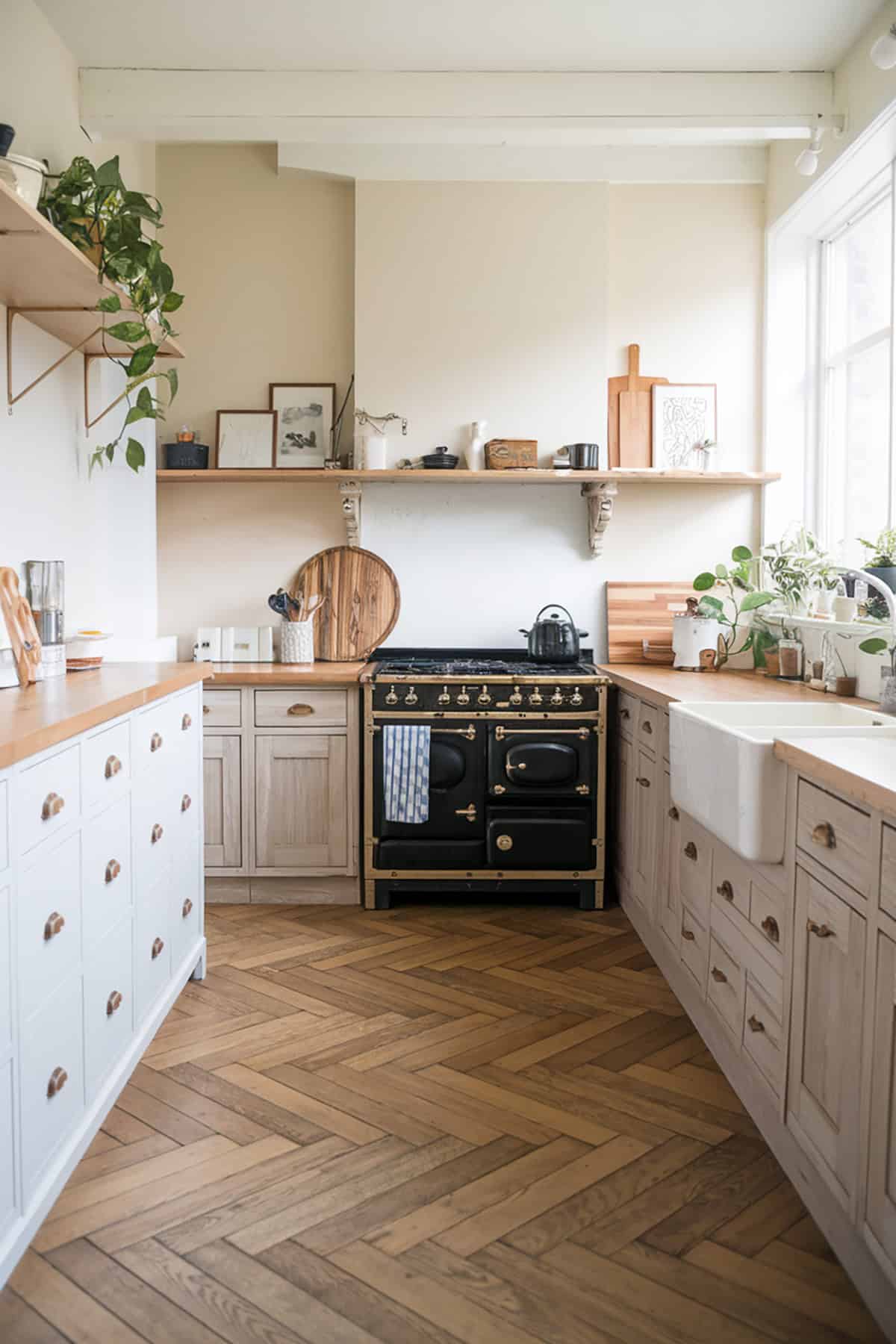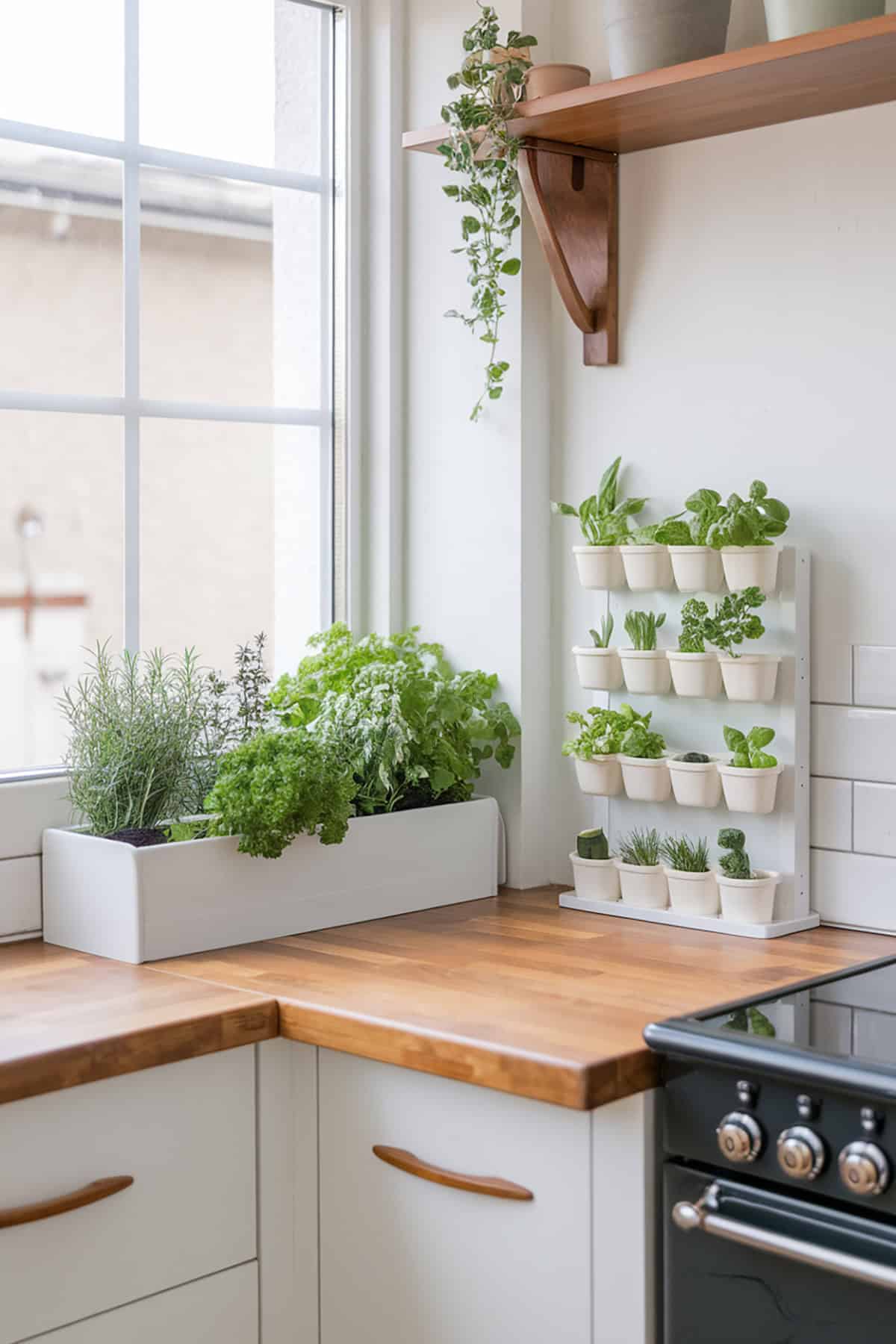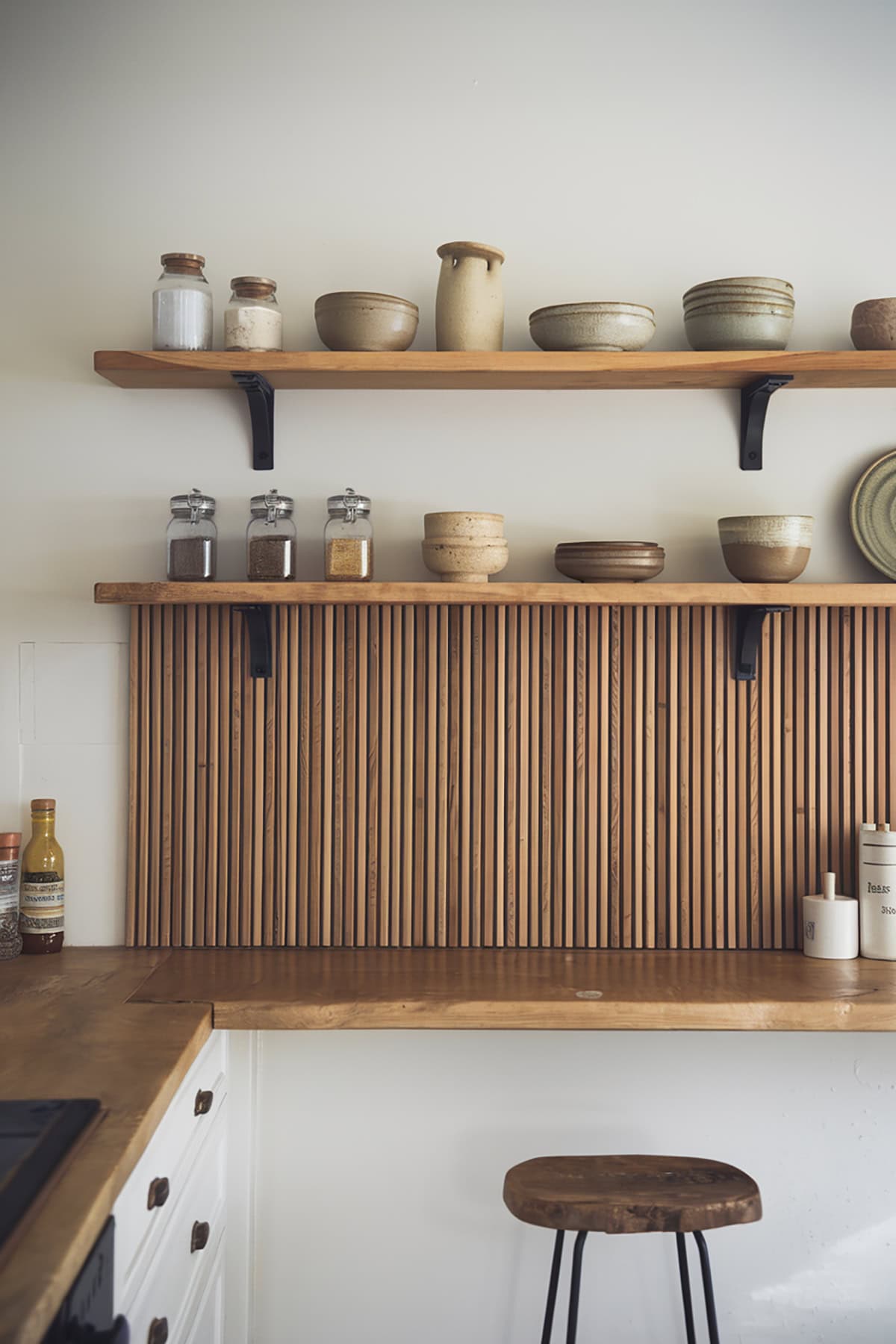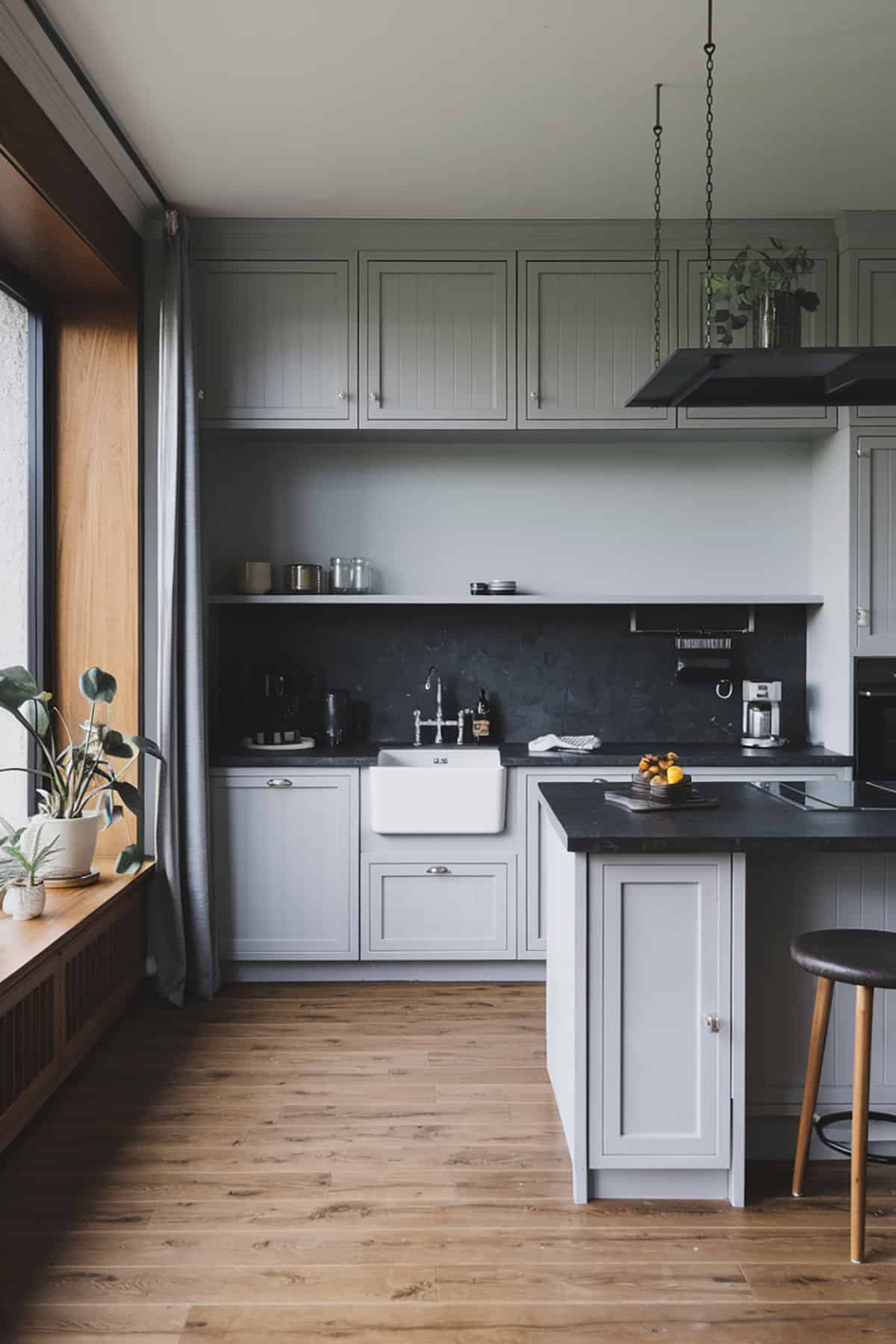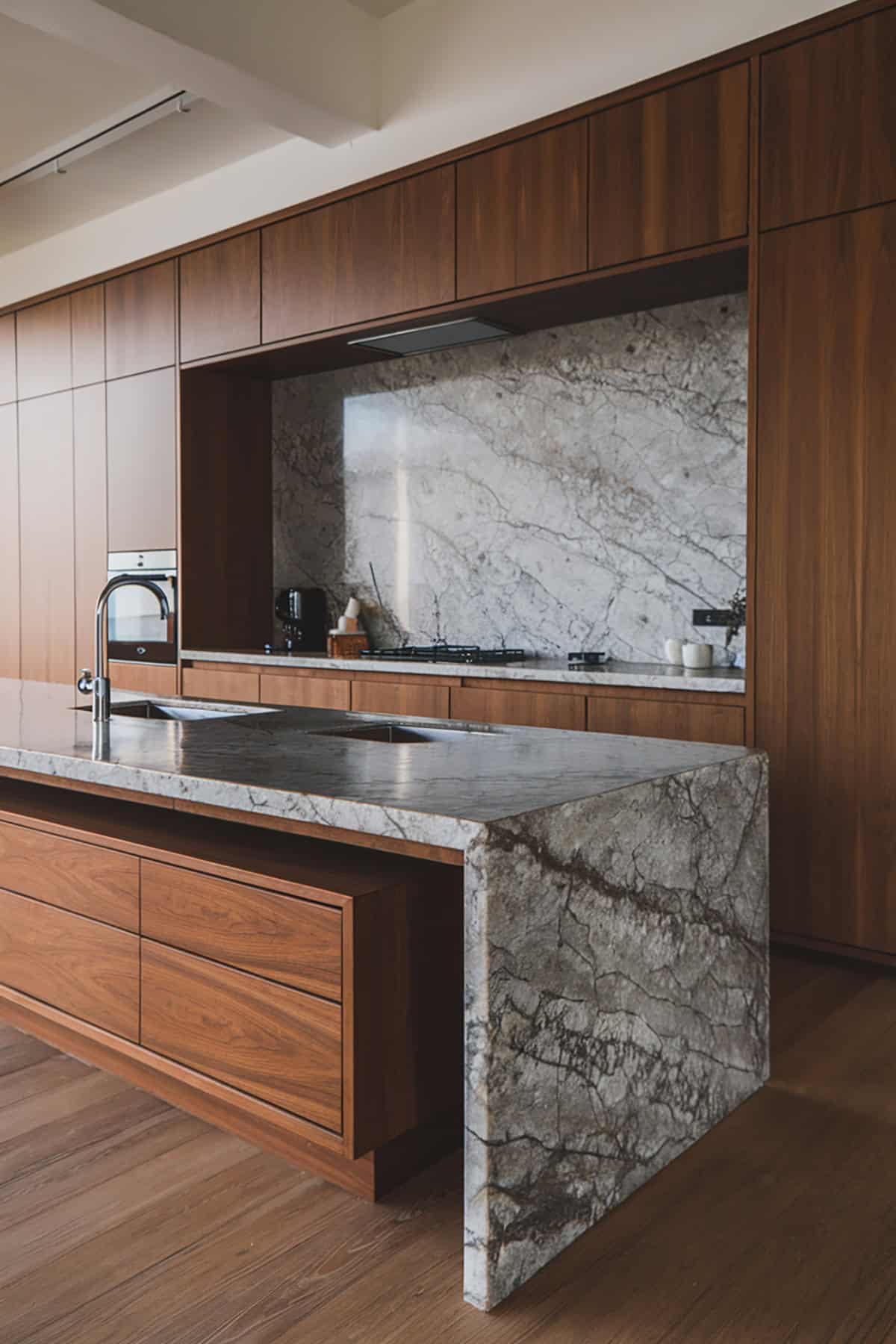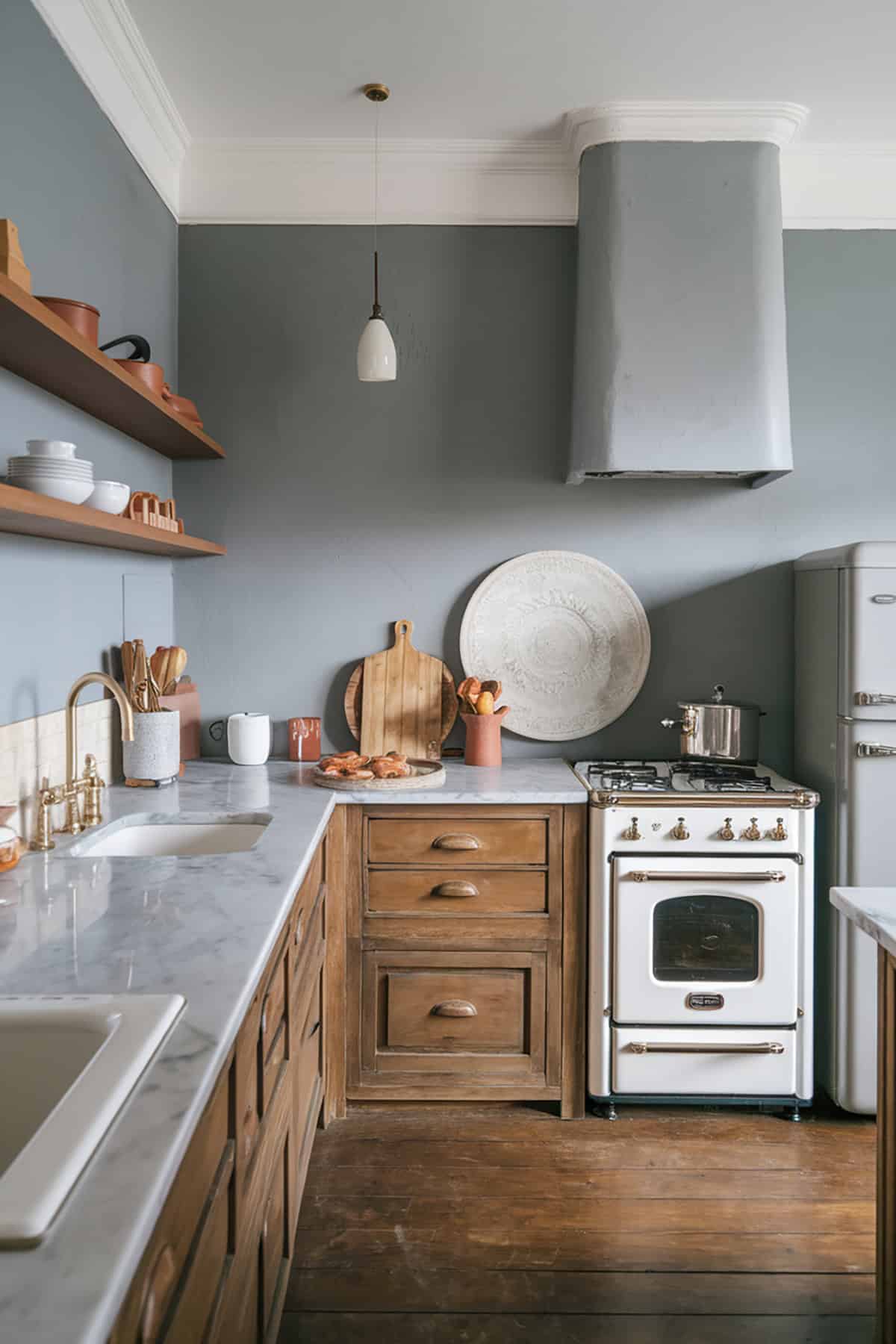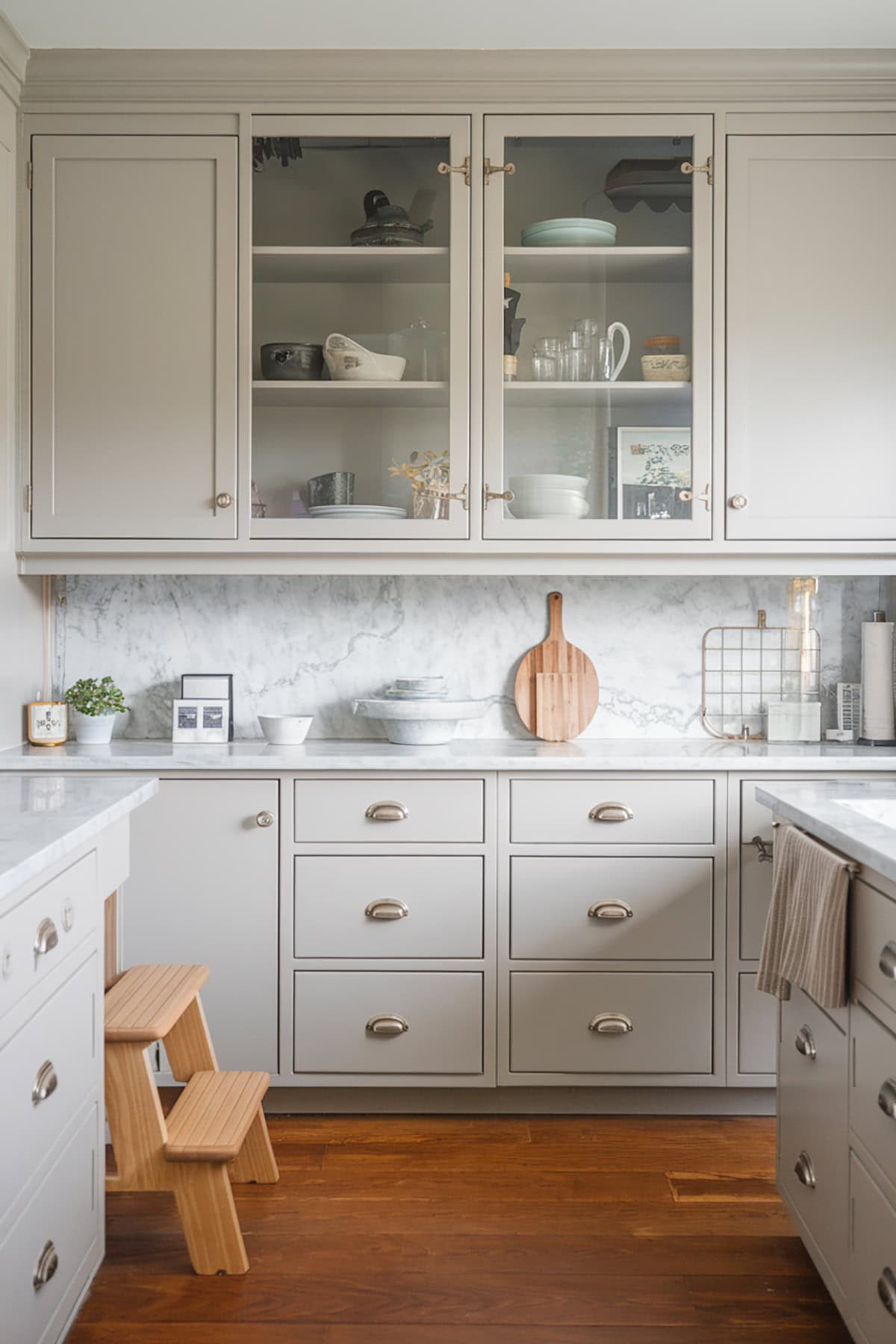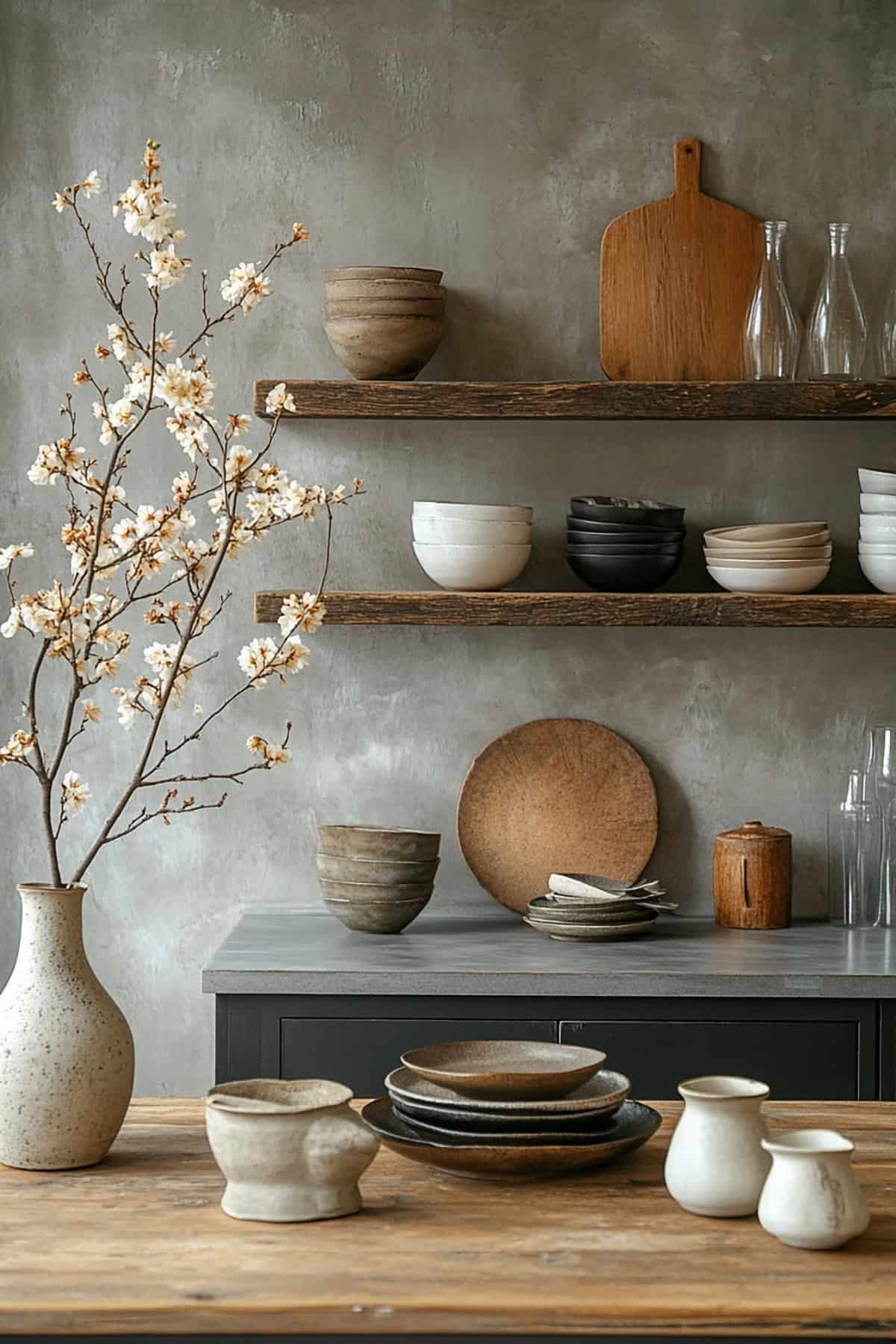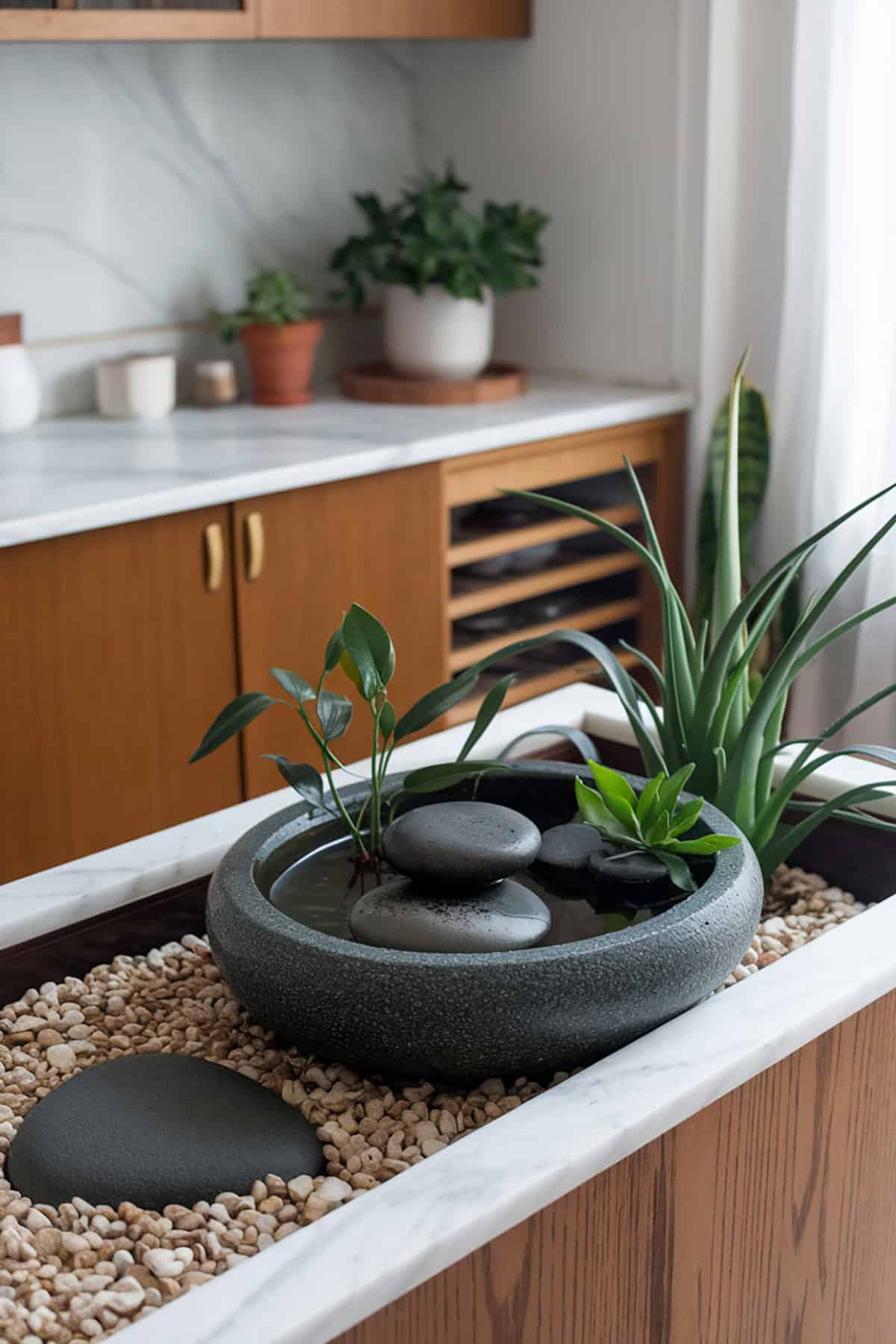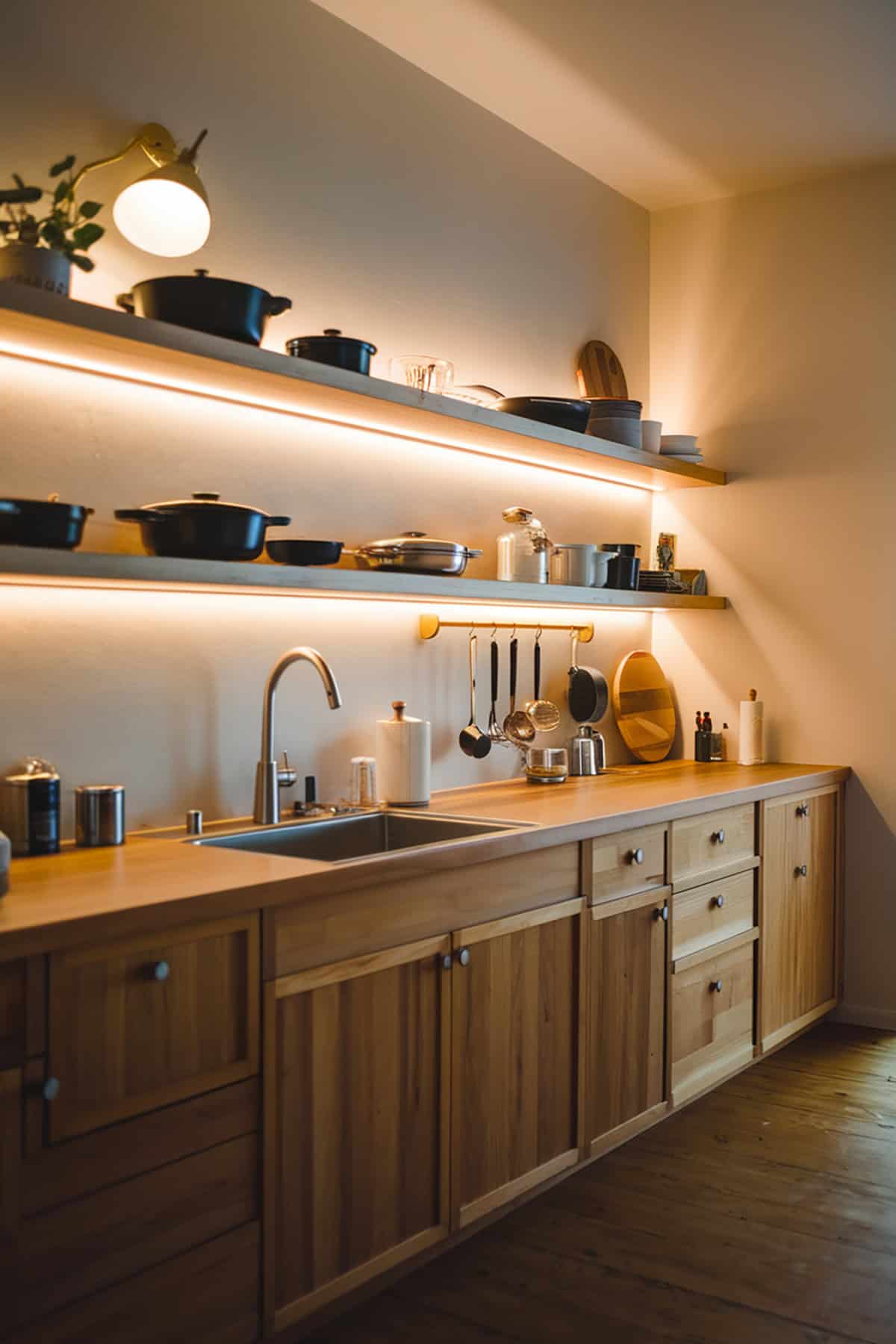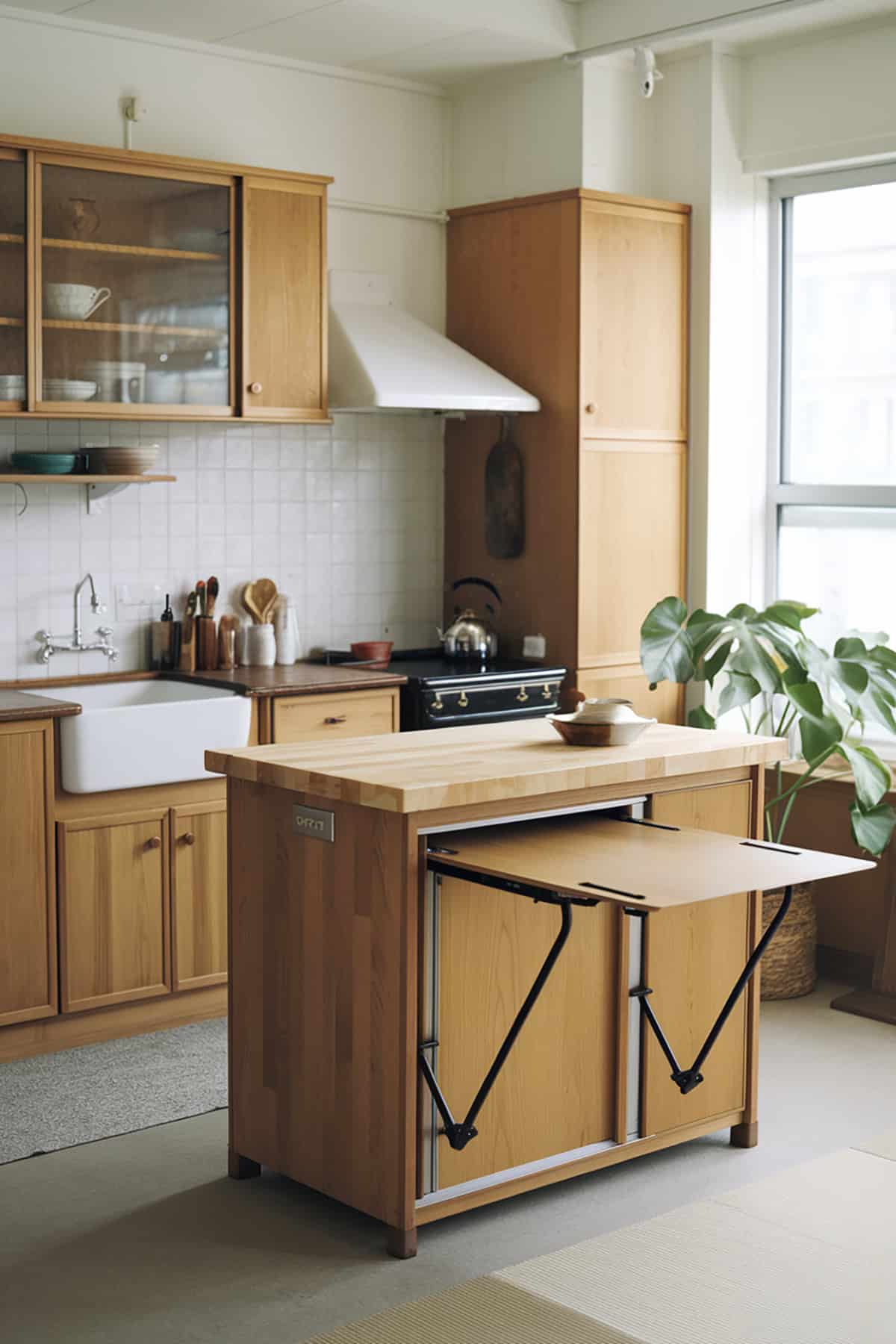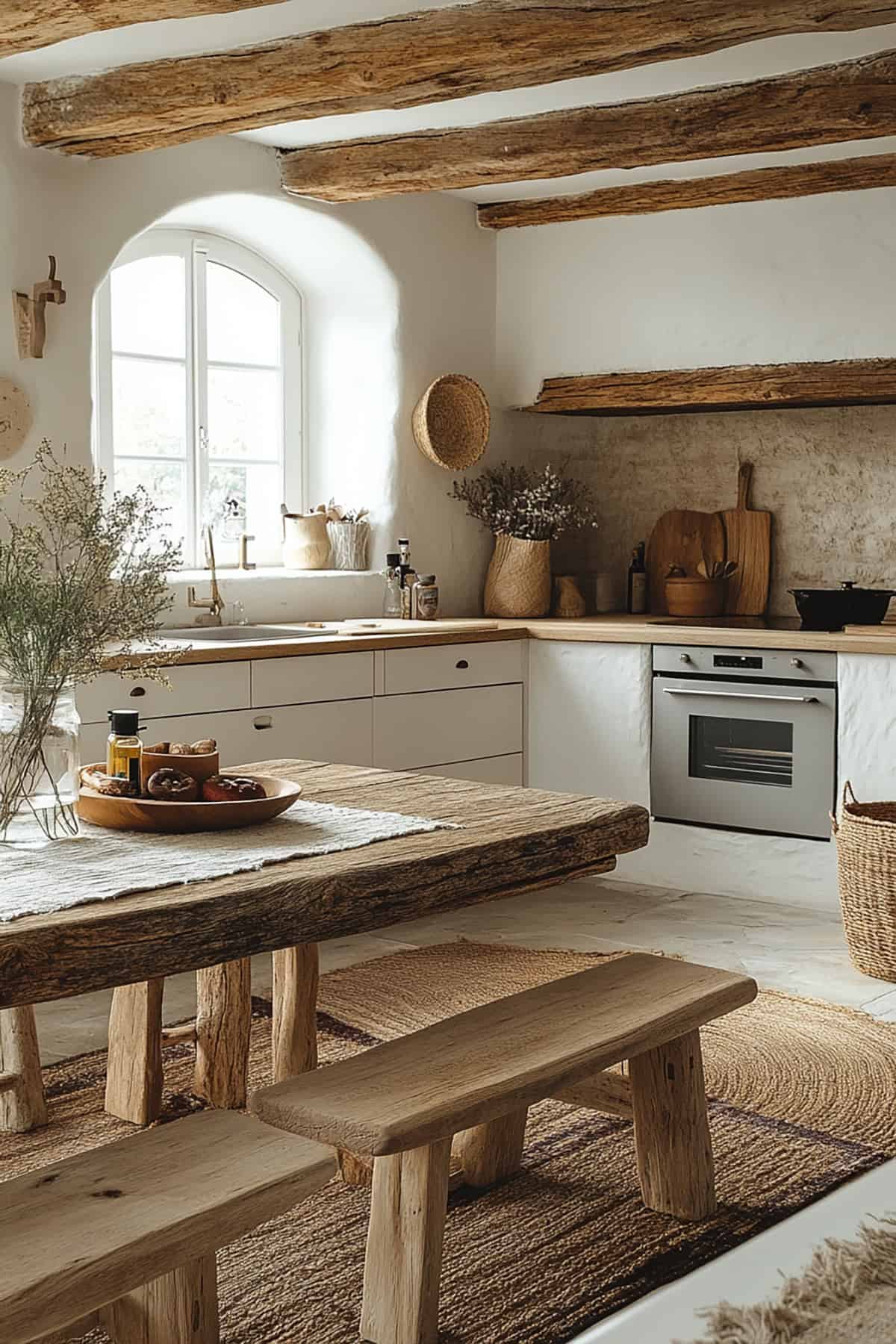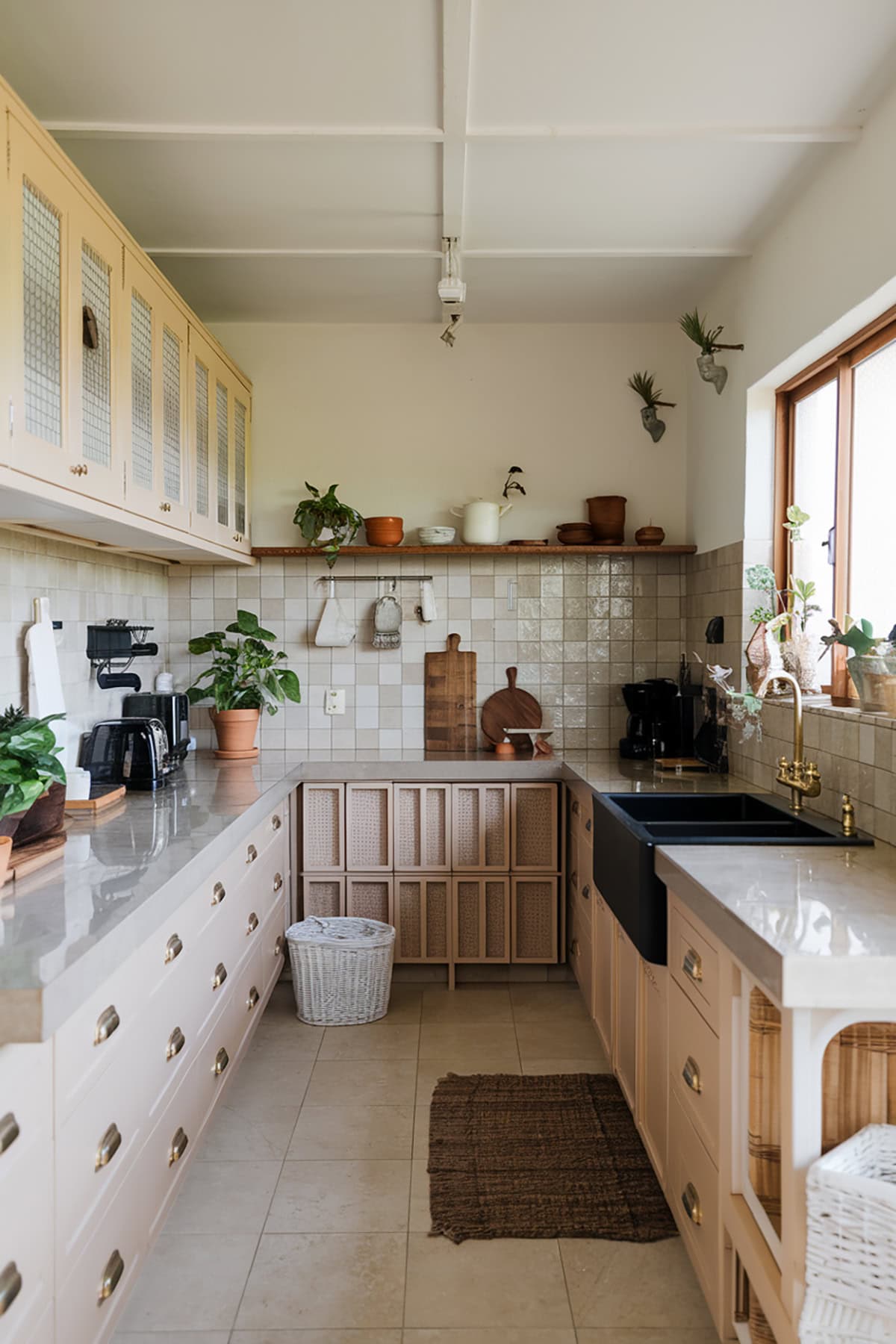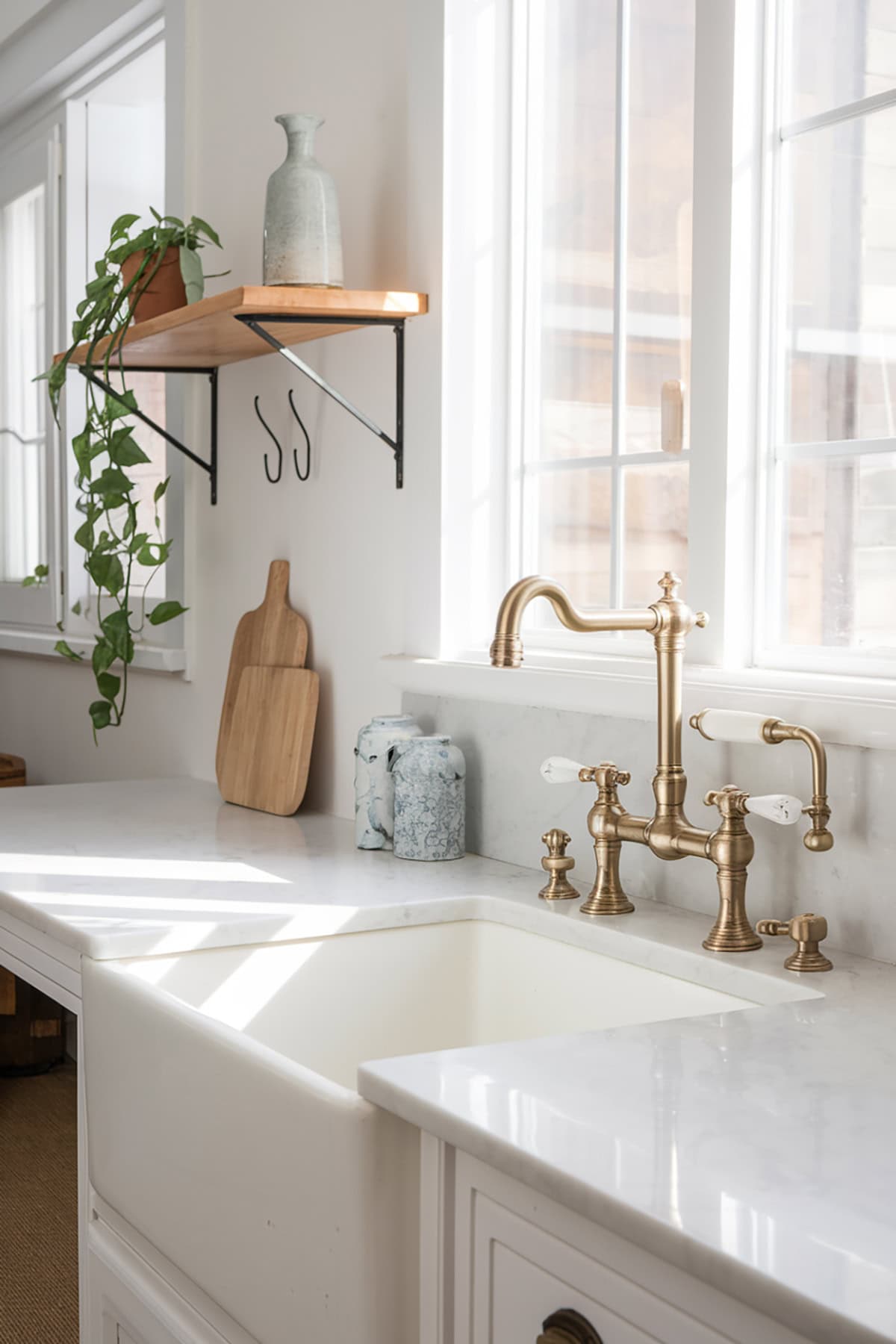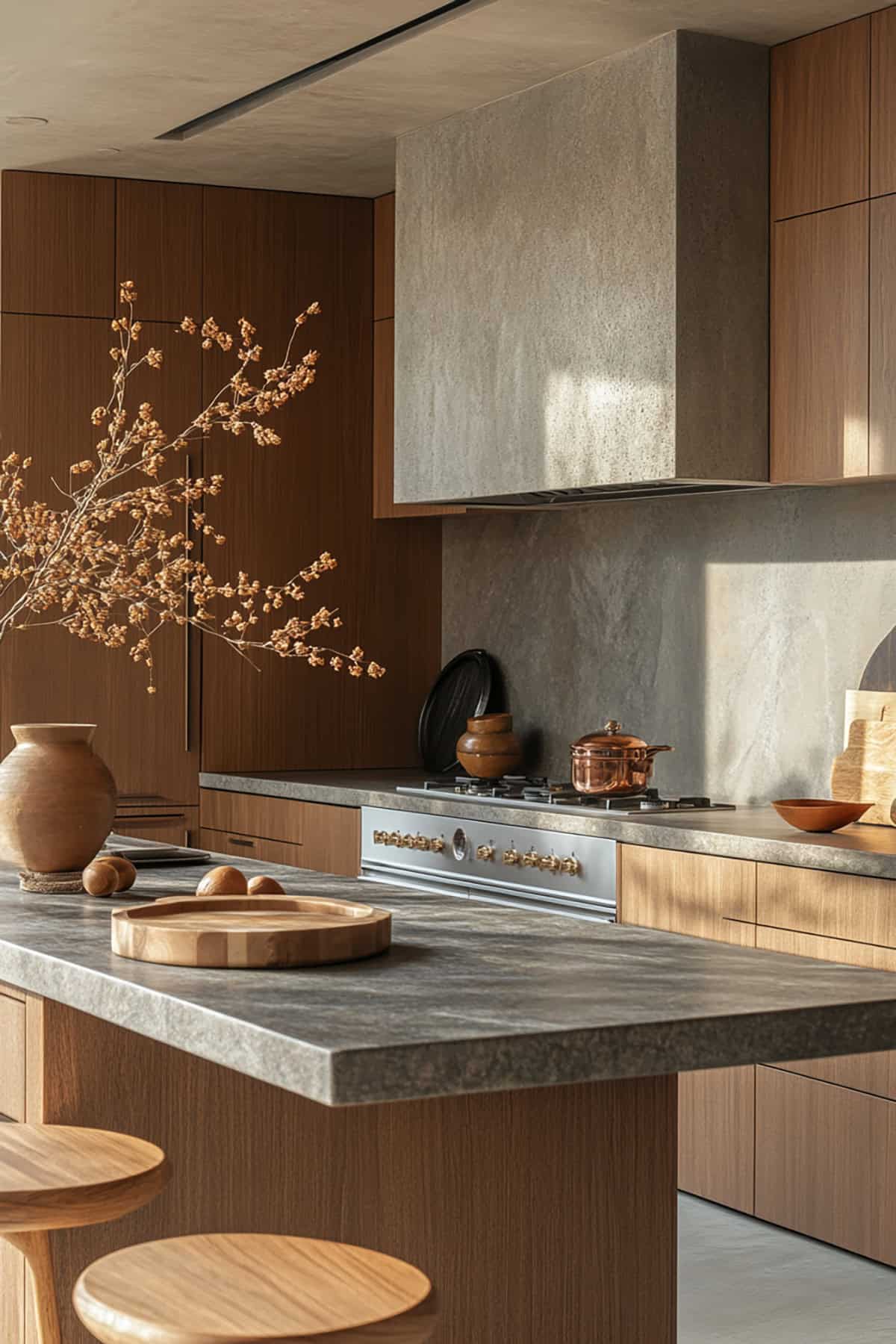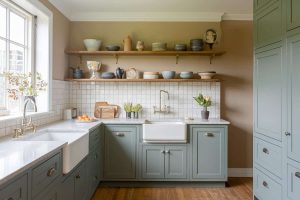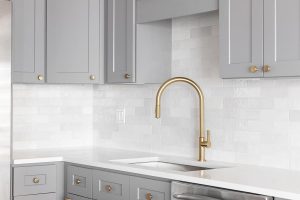Your kitchen should be more than just a place to cook—it should be a peaceful retreat. Japandi design blends the clean lines of Scandinavian style with the natural elegance of Japanese minimalism, creating a space that is both calming and functional. These 32 Japandi kitchen ideas will help you achieve a timeless and harmonious design.
How to Plan a Japandi Kitchen
A Japandi kitchen is more than just a design trend—it’s a philosophy that prioritizes simplicity, functionality, and the beauty of natural materials. Here’s how to plan it.
Embracing Japandi Design
Planning a Japandi kitchen involves combining elements of Japanese and Scandinavian design. Focus on simplicity and functionality while using natural materials and clean lines to create a harmonious space.
Choosing a Neutral Color Palette
Start with a neutral color palette to set the foundation of your Japandi kitchen. Whites, beiges, and light grays work well to create a calming environment. Add warmth through wooden elements like cabinetry, shelving, and flooring.
Maximizing Natural Light
Japanese design principles emphasize natural light, so ensure your kitchen layout allows for maximum brightness. Use large windows, light curtains, and reflective surfaces to enhance illumination.
Prioritizing Organization and Minimalism
Opt for open shelving instead of closed cabinets to encourage a clutter-free space and easy accessibility. Declutter the kitchen by using smart storage solutions that maintain order and efficiency.
Incorporating Sustainable Practices
Sustainability is at the heart of Japandi design. Choose eco-friendly materials such as bamboo or reclaimed wood for countertops and cabinetry. Energy-efficient appliances further enhance the modern, eco-conscious aesthetic.
Balancing Aesthetics and Functionality
Simplicity is key when selecting fixtures and finishes. Opt for sleek, minimalist faucets and cabinet handles while introducing natural textures through textiles like linen or cotton for curtains and tablecloths.
Achieving Harmony in Design
Every element in a Japandi kitchen should complement the others without overpowering the space. Choose decor, materials, and layouts that blend seamlessly for a serene and functional kitchen environment.
Japandi Kitchen Design Ideas
Japandi kitchen design beautifully merges Japanese elegance with Scandinavian simplicity. Key elements often include natural tones, minimalist aesthetics, and functional beauty. This fusion focuses on creating modern, serene spaces.
Light Wood Cabinetry For A Natural Aesthetic
Choose light wood cabinetry for its warm, inviting feel. It complements the Japandi style by adding a natural element. Woods like ash or oak are perfect choices. They provide a neutral backdrop while enhancing the kitchen’s atmosphere. Ensure the finish is smooth and subtle, preserving the wood’s natural look. The simplicity of light wood balances well with other Japandi elements.
Earthy Neutral Color Palette
Incorporate an earthy neutral color palette. Shades like beige, taupe, and soft grays work well. These colors offer calm and balance, essential in Japandi design. Pair them with natural materials to elevate the kitchen space. The palette should not overwhelm but blend seamlessly to create a harmonious look.
Open Shelving With Minimalist Styling
Open shelving brings an airy feel and minimalist touch. Consider natural wood shelves to maintain a warm appearance. Style them sparsely to avoid clutter, emphasizing functionality and simplicity. Display items like ceramic dishware or glass jars. This approach highlights the aesthetic and practical elements of Japandi kitchens.
Sliding Shoji-Inspired Cabinet Doors
Sliding Shoji-inspired cabinet doors add subtlety and elegance. These doors open smoothly, offering sleek functionality. They often feature translucent materials, providing privacy while allowing light diffusion. Such doors are lightweight and space-saving. They blend tradition with innovative design in your kitchen.
Japandi-Inspired Kitchen Island
A Japandi-inspired kitchen island truly transforms the space. Opt for clean lines and simple shapes. Choose natural materials like wood or stone. The island’s design should facilitate easy movement and functionality. It can serve as both a preparation area and a dining space.
Integrated Hidden Storage Solutions
Hidden storage solutions enhance the minimalist appeal. Consider built-in cabinets with seamless doors. Utilize every inch of space by installing pull-out drawers and corner cabinets. This feature keeps the kitchen uncluttered. It preserves the clean aesthetic central to Japandi style.
Minimalist Pendant Lighting With Organic Shapes
Minimalist pendant lighting adds focus and style. Choose designs with organic shapes, resembling nature’s simplicity. Materials like wood, metal, or paper reflect Japandi values. Install them above islands or dining areas for ambient lighting. This choice combines functionality and elegance.
Stone Or Concrete Backsplash For Subtle Texture
Use a stone or concrete backsplash for texture. These materials add depth but remain understated. Their muted colors blend effortlessly into the color palette. A textured backsplash enhances visual interest without overshadowing other elements. It’s durable and easy to maintain, fitting seamlessly into the Japandi design ethos.
Black Accents For Contrast And Definition
Incorporate black accents to create contrast. This could be through fixtures, handles, or frames. Black defines space and adds modern sophistication. It offsets the lighter elements, ensuring balance in design. The strategic use of black enhances the overall cohesion while maintaining the minimalist look.
Built-In Wooden Bench For A Cozy Breakfast Nook
A built-in wooden bench offers warmth and functionality. Pair it with a small, low table for an inviting nook. Choose soft wood tones to align with the Japandi palette. Include some cushions for added comfort. This creates a cozy space for relaxed dining or enjoying a cup of tea.
Handmade Ceramic Dishware For An Authentic Touch
Handmade ceramic dishware adds authenticity and elegance. Select pieces with natural shapes and muted tones. Display them on open shelves for a touch of personal style. The handcrafted quality aligns with the artisanal emphasis of Japandi. It reinforces a connection to nature and simplicity.
Bamboo And Rattan Accents For Natural Texture
Incorporate bamboo and rattan accents for texture. Consider using them in decor, light fixtures, or furniture. These materials highlight the natural theme prevalent in Japandi design. They are sustainable choices that add tactile interest. Bamboo and rattan seamlessly blend comfort with minimalist style.
Black-Framed Glass Partitions For An Open Layout
Black-framed glass partitions create an open feeling. They allow light to flow but still define spaces. This modern touch suits a Japandi design, providing structure without heaviness. Such partitions can separate the kitchen from dining or living areas. Their clear lines enhance visibility and connectivity.
Soft Linen Curtains For Natural Light Diffusion
Soft linen curtains diffuse natural light beautifully. They add an airy, soft touch to windows. Choose neutral colors that complement the surrounding color palette. Linen’s texture aligns with the Japandi focus on natural materials. These curtains subtly control lighting while maintaining simplicity.
Vertical Paneling On Cabinet Doors For Texture
Use vertical paneling on cabinet doors for additional texture. This design aspect provides subtle visual interest without overwhelming. It complements the kitchen’s natural elements. Choose paneling that matches the overall wood tone. The vertical lines enhance the sense of height and space.
Textured Walls With Limewash Or Plaster Finish
Textured walls with limewash or plaster offer rustic elegance. These finishes add depth while blending with natural aesthetics. The texture subtly interacts with light, creating shadows and highlights. Such walls are versatile, aligning with Japandi’s minimalist and organic roots.
Muted Herringbone Wood Flooring For Visual Interest
Opt for muted herringbone wood flooring to enhance visual interest. This pattern adds complexity while remaining understated. Choose finishes that match the kitchen’s palette to ensure harmony. Herringbone layout elevates the flooring beyond simple planks, offering a sophisticated look.
Integrated Herb Garden For Functionality
An integrated herb garden adds both beauty and utility. Plant it near a window for natural light. Incorporate herbs like basil, mint, or thyme. This feature not only serves culinary purposes but enhances the kitchen’s connection to nature. It provides freshness and greenery.
Floating Wooden Shelves With Minimal Decor
Floating wooden shelves emphasize minimalism and functionality. Use them to showcase select decor items or essentials. Choose wood that matches the cabinetry for continuity. Limit items to keep the design light and open. These shelves provide storage without adding bulk.
Monochromatic Gray Japandi Kitchen For A Modern Touch
Design a monochromatic gray kitchen for modernity. Use varying shades of gray to add depth and contrast. Maintain clean lines and simple forms. This color scheme provides a sleek appearance, ensuring that other features stand out. A gray kitchen maintains tranquility and stylistic unity.
Waterfall Edge Countertop For Sculptural Elegance
Choose a waterfall edge countertop for its elegance. It brings smooth lines and a cohesive flow to kitchen design. Material options like marble or quartz enhance the luxurious feel. This countertop design draws attention, serving as a centerpiece while offering practicality.
Muted Clay Or Terracotta Accents For Warmth
Muted clay or terracotta accents infuse warmth. Integrate these through small decor items, planters, or utensils. Their earthy tones balance cooler elements within the kitchen. These accents draw from the natural clay materials seen in both Japanese and Scandinavian designs.
Frameless Cabinetry For Seamless Elegance
Frameless cabinetry offers clean lines and a modern look. The absence of visible frames accentuates the cabinetry’s smooth fronts. It aligns with Japandi’s preference for unbroken surfaces. Selected finishes should harmonize with the overall aesthetic, enhancing elegance.
Wabi-Sabi Decorative Accents
Incorporate Wabi-Sabi decorative accents that emphasize beauty in imperfection. Consider handmade pottery or rustic wooden objects. These items add character with their unique imperfections. They showcase Japandi’s appreciation for simplicity and natural beauty. Wabi-Sabi elements personalize the kitchen space with authenticity.
Zen-Inspired Indoor Water Feature
Introduce a Zen-inspired indoor water feature. It provides a calming auditory element. Consider small fountains or water walls. This feature enhances the serene environment integral to Japandi design. Its presence promotes relaxation and tranquility.
Hidden LED Strip Lighting For Ambiance
Utilize hidden LED strip lighting for ambiance. Place strips under cabinets or shelves. Their subtle illumination highlights features without overwhelming. They’re energy-efficient, offering practical lighting. The soft glow enhances the kitchen’s mood and functionality.
Foldable Or Sliding Dining Table For Small Kitchens
Opt for a foldable or sliding dining table for versatile space usage. They save space while remaining functional. When not in use, they can be tucked away to maintain openness. Their design aligns with Japandi’s efficient and minimalist ethos.
Rustic Wooden Ceiling Beams For Warmth
Rustic wooden ceiling beams add warmth and character. They introduce texture and complement a natural aesthetic. These beams enhance the kitchen’s cozy atmosphere. Choose wood that aligns with other wooden elements to ensure design cohesion.
A Mix Of Matte And Glossy Finishes For Depth
Mix matte and glossy finishes to provide depth. Contrast matte cabinets with glossy countertops. This combination reflects and diffuses light differently, adding visual interest. Balance both finishes for a cohesive look that remains elegant.
Minimalist Kitchen Accessories In Natural Materials
Choose minimalist kitchen accessories made of natural materials. Consider wooden utensils, stone bowls, or rattan baskets. These items support the minimalist approach. They add subtle details that enhance functionality and aesthetics without distracting from the overall design.
Understated Japandi-Inspired Hardware
Select understated hardware aligning with Japandi’s minimalism. Opt for simple shapes and natural finishes. Consider materials like brushed metal or wood. These details ensure cohesion across the design, enhancing rather than distracting.
Scandinavian Simplicity Meets Japanese Functionality
Embrace the harmonious marriage of Scandinavian simplicity and Japanese functionality in your kitchen design. Focus on efficiency and flow. Select features and layouts that are straightforward. This combination creates spaces that are as beautiful as they are practical.
